Vol. 68, No. 6 (2019)
2019-03-20
GENERAL
2019, 68 (6): 060401.
doi:10.7498/aps.68.20182050
Abstract +
In this paper, the Lorentz-violating scalar field equation is generalized in curved spacetime, and we find that the aether-like terms modify the scalar field equation, so that the effect can correct the properties near the event horizon of black hole spacetime. We then obtain the modified Hamilton-Jacobi equation by semi-classical approximation, and investigate the Hawking radiation and black hole thermodynamics in Schwarzschild black hole spacetime. The results show that the effects of aether-like terms increase the temperature of black hole, but reduce the entropy of black hole as
${{ u}^\alpha } = {\text{δ}}_t^\alpha {u^t}, {\text{δ}}_r^\alpha {u^r}$
. This work can help to understand the properties of Lorentz-violating in curved spacetime.
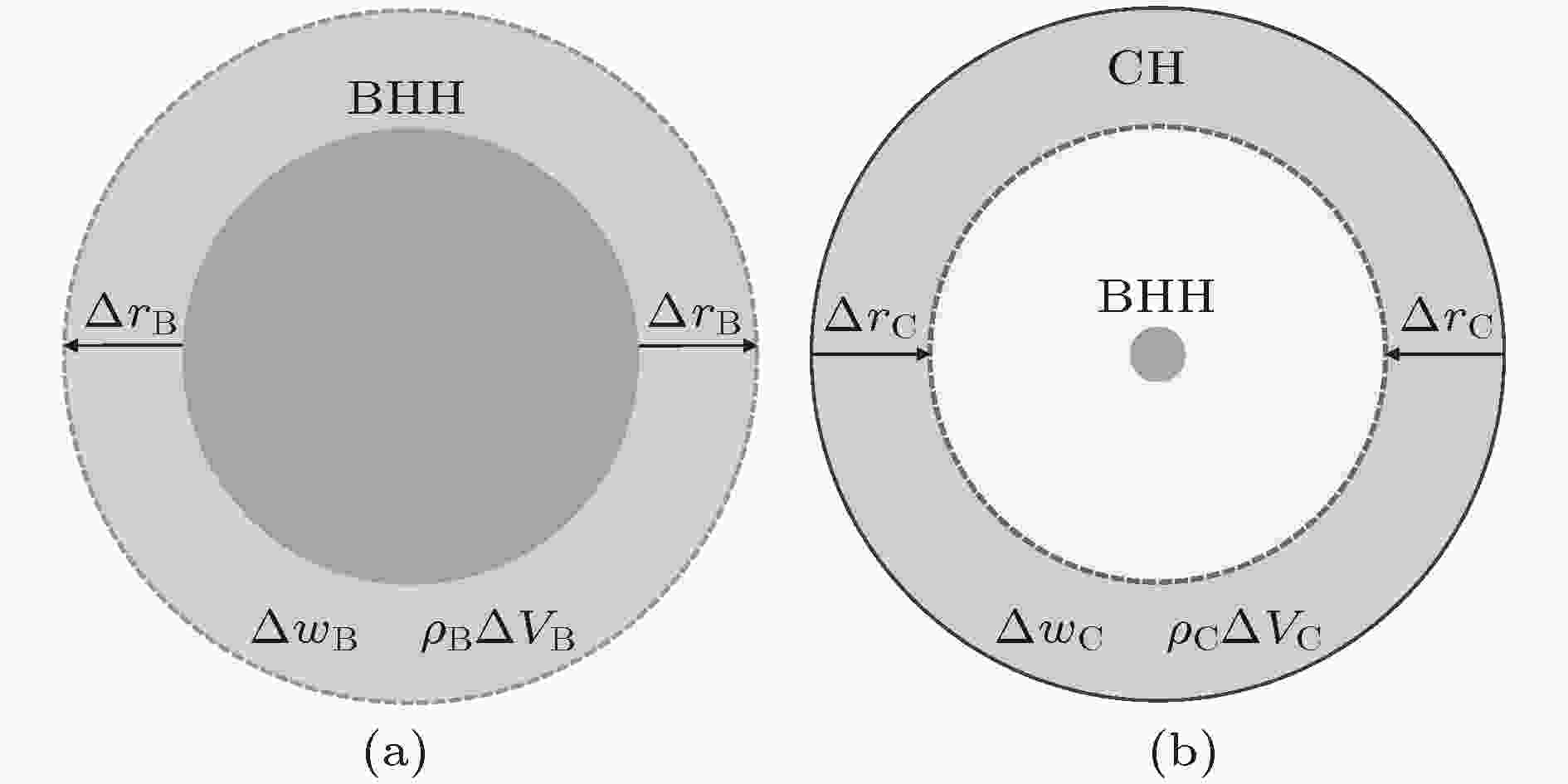
2019, 68 (6): 060402.
doi:10.7498/aps.68.20182055
Abstract +
Kiselev black hole possesses the two horizons, i.e. the inner horizon and outer horizon. In some cases, the so-called outer horizon of black hole is actually a cosmic horizon. In this paper, Kiselev space-time with black hole horizon and cosmic horizon is considered. The radius of black hole horizon and the radius of cosmic horizon are approximately obtained to be
$r_{\rm B} \approx 2M \left[ 1 + \left(2M/{\lambda}\right)^{-(3w_{\rm {\rm q}}+1)} \right]$
and
$r_{\rm C} \approx \lambda + \dfrac{2M} {3w_{\rm {\rm q}}+1}$
with
$M \ll \lambda$
and
$w_{\rm q}$
a parameter. The energy density of the Kiselev spacetime near the cosmic horizon is approximately proportional to
$w_{\rm q}$
, so the energy densities with some different
$ w_{\rm q}$
have the same order of magnitude in the range
$-1
. Near the black hole horizon, it increases rapidly with the increase of
$w_{\rm q}$
. The thermodynamic properties of the systems with black hole horizon and cosmic horizon as boundary are studied. The first law of thermodynamics for the two systems is given in a unified way. Similarly, Smarr relation for the mass of Kiselev black hole is also obtained. For
$M \ll \lambda $
, the work done by the fluid on the cosmic horizon and the thermal energy flux flowing into the cosmic horizon of Kiselev spacetime are calculated approximately. In the range of
$-1 < w_{\rm q} < - 1/3 $
, the thermal energy always flows out of the cosmic horizon. The work done by the fluid on the black hole horizon is much smaller than the change in the energy of black hole,
$\Delta w_{\rm B} \ll \Delta r_{\rm B}$
. This indicates that the energy increase of black hole comes mainly from the thermal energy flowing into the black hole through its outer horizon. The problem of accreting the pressureless fluid into Kiselev black hole is discussed. One can find that there are the zero gravity surfaces between the black hole horizon and cosmic horizon of Kiselev spacetime, the radii of which increase with the decrease of
$w_{\rm q}$
. For
$w_{\rm q}=-\dfrac{2}{3}$
and
$w_{\rm q}=-1$
, the accretion radii of Kiselev black hole are respectively determined to be
$r_0 \approx 1.6 \times 10^{4}$
(l.y.) and
$r_0 \approx 1.2 \times 10^{6}$
(l.y.). On condition that the accretion energy density is proportional to the background energy density,
$\rho_{\rm {mB}} = \eta_{\rm B} \rho_{\rm B}$
with
$\eta_{\rm B}$
being a proportionality coefficient, the accretion rate of Kiselev black hole is given as
$\chi_{\rm B} = - \dfrac{3 \eta_{\rm B} w_{\rm q}} {2} \left(\dfrac{2M}{\lambda}\right)^{-(3w_{\rm q} + 1)}$
. For
$w_{\rm q}= - 2/3 $
, the accretion rate of the black hole takes its maximum
$\chi_{\rm max} \approx 1.2 \times 10^{- 6} \eta_{\rm B} $
; for
$w_{\rm q}= - 1$
, the accretion rate takes its minimum
$\chi_ {\rm {min}} \approx 1.2 \times 10 ^ {-8} \eta_{\rm B} $
. On the assumption that
$\eta_{\rm B}$
changes slowly enough with
$w_{\rm q}$
, the accretion rate of Kiselev black hole increases with the increase of
$w_{\rm q}$
.
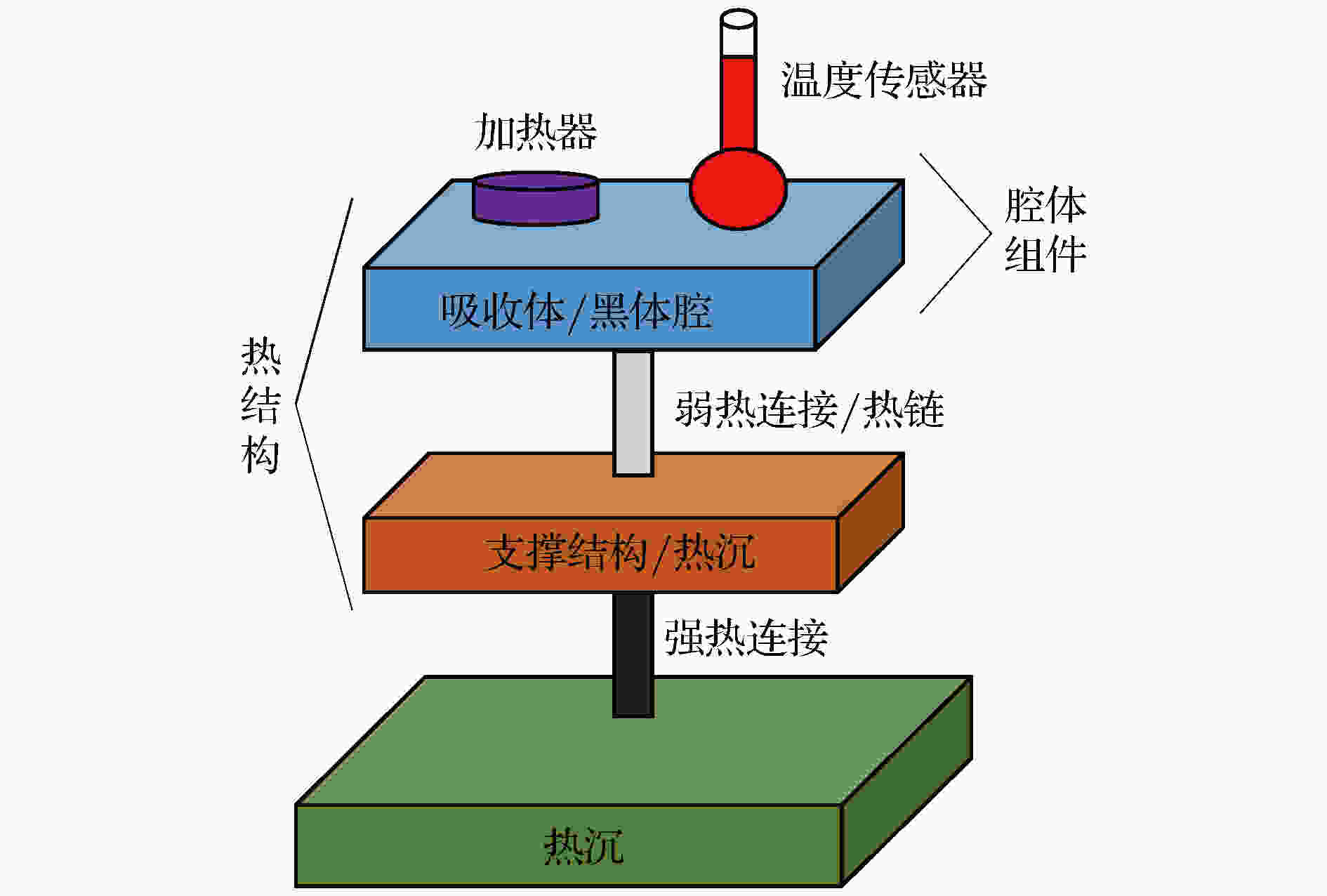
2019, 68 (6): 060601.
doi:10.7498/aps.68.20181880
Abstract +
Absolute cryogenic radiometer is built based on a new theory of electrical-substitution measurement, which is for measuring the radiant power by using the equivalent electrical power and has recently served as a primary standard for radiant power measurements. This study aims to design and implement a cryogenic radiometers to measure the optical power in a range from
$0.1\;{\text{μ}}{\rm{W}}$
to 2 mW, which can substitute for the imported products. Intensive experiments are performed to study the thermal circuit of cryogenic radiometer, and systematically analyze the influences of cavity assembly and heat link materials on the responsivity and thermal time constant of cryogenic radiometer. On this basis, the thermo-structure mechanical parts are developed, which are comprised of a blackbody cavity, heat link and heat sink. Both the heat sink and the blackbody cavity are made of OFHC copper that is plated with gold. All surfaces are highly polished and reflective to reduce any radiative effects. The absorptance of the cavity can reach up to 0.999995 at 633 nm. And then, a characteristic parameters’ test system of cryogenic radiometer is built. Through optimizing the temperature control system and improving the design of the heat sink, the standard deviation of the heat sink can be kept under 0.2 mK for 30 min. By using that test system, the responsivity and thermal time constant of cryogenic radiometer with four different kinds of heat link materials (OHFC copper, 6061 Al, SS304 stainless steel, and polyimide) are tested experimentally. The experimental results show that the responsivity and thermal time constant are 35.5 K/W and 23 s for OHFC copper, 318.9 K/W and 106 s for 6061 Al, 434.8 K/W and 297 s for SS304 stainless steel, 714.8 K/W and 506 s for polyimide. As the thermal conductivity of heat link material changes, the two parameters of responsivity and thermal time constant will simultaneously change significantly. The responsivity and thermal time constant are a pair of mutually constrained parameters, and temperature stability is an important parameter for designing the thermo-structure. After increasing the responsivity, it will not only significantly increase the measurement time and resource consumption, but also affect the temperature control stability, and hence limiting the measurement accuracy. All the test data indicate that the characteristic parameter of cryogenic radiometer can be adjusted by changing the material and structure of heat link. The obtained results will have a certain reference value for the index distribution of cryogenic radiometer characteristic parameters and designing the next generation of absolute cryogenic radiometers.
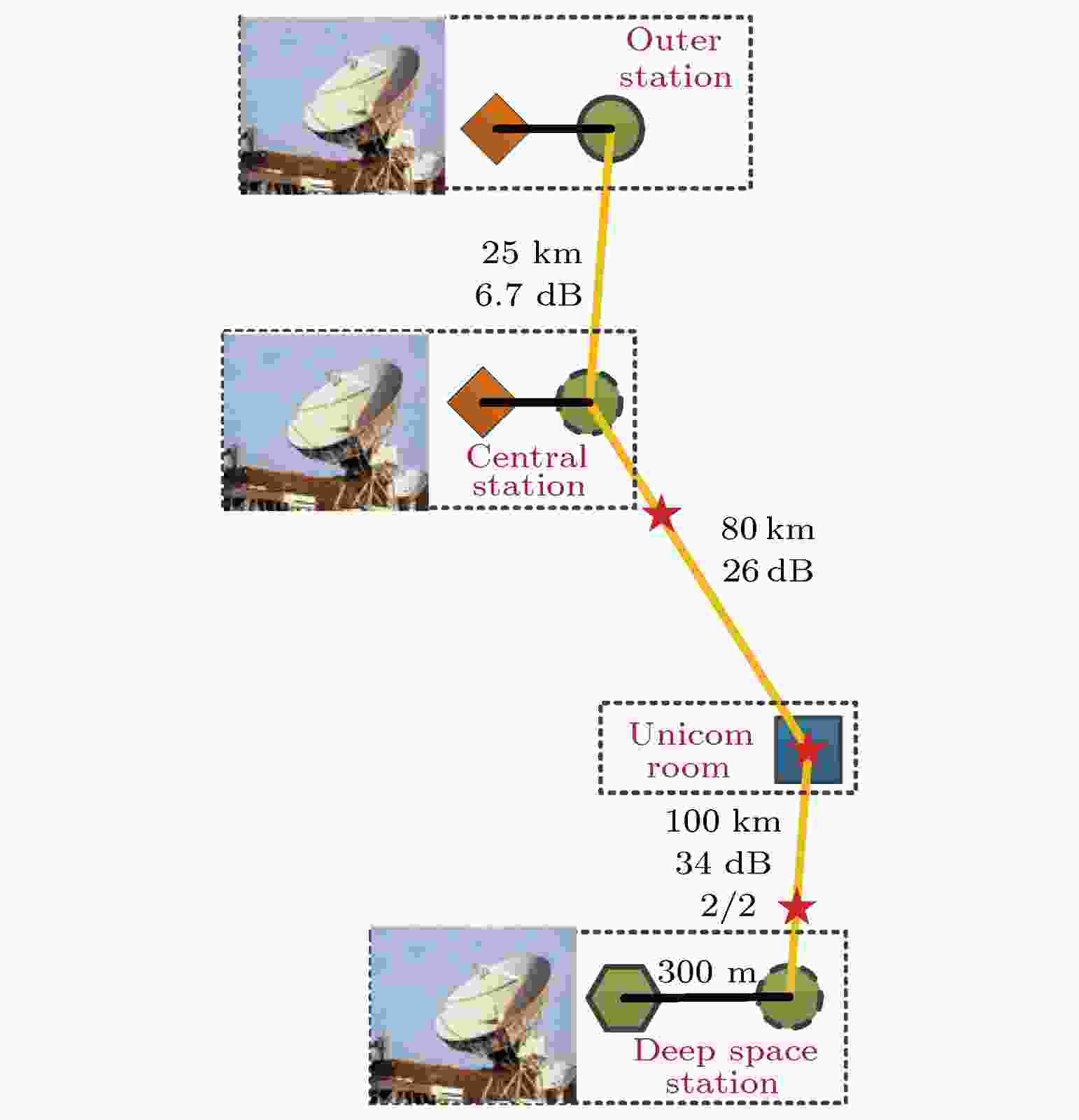
COVER ARTICLE
2019, 68 (6): 060602.
doi:10.7498/aps.68.20182000
Abstract +
The precise time and frequency signal dissemination has significant applications in scientific research such as baseline interferometry, deep space network and metrology. Aside from satellite based systems, optical fiber has become an attractive alternative medium for transferring time and frequency signals, offering much improved accuracy. For the urban fiber link in the desert environment, there are many complex noise sources, such as temperature change, outdoor wind and ground vibration. Therefore, a systematical study on the noise source and on the noise reduction method in the dessert environment have practical significance. In this paper, we demonstrate a time (1 pps) and frequency signal dissemination and time synchronization system through a 200 km urban fiber in dessert environment. The noise source of the urban fiber under dessert environment is analyzed and studied in detail; the results show that the vibration and temperature shift are the major influencing factors. The vibration of urban fiber can induce the noise in the high Fourier frequency, and the temperature shift of urban fiber can induce the noise at a low Fourier frequency. An optical compensation setup is used, including the optical delay line with temperature controlled and piezoelectric ceramics driving. The phase fluctuation of frequency signal is detected and used to control the feedback of the optical compensating setup. In order to compensate for the fiber loss in a long range, a special bi-directional erbium-doped fiber amplifier is used to regenerate optical signals to achieve the long distance transmission. Then, we study the effective link noise suppression technology under different feedback compensation parameters. The systematic feedback parameters are optimized through using the different system feedback bandwidths, feedback intensities, optical power and other key parameters. The optimized systematic feedback parameters are obtained via the careful experimental observation and discussion. With the optimized systematic feedback parameters, experimental results show that the frequency stabilities are up to 8 × 10–14at 1 s and 1 × 10–16at 1000 s, and time stabilities are up to 1.2 ps in an average time of 103s. The phase stabilized transmission of hydrogen clock signal in the 200 km level desert environment urban fiber link is realized. The verification experiment plays an important role in measuring the satellite orbit based on a connected elements’ interferometry. The relevant study result is of significance for improving the precision of time and frequency signal dissemination in the dessert environmental urban fiber.
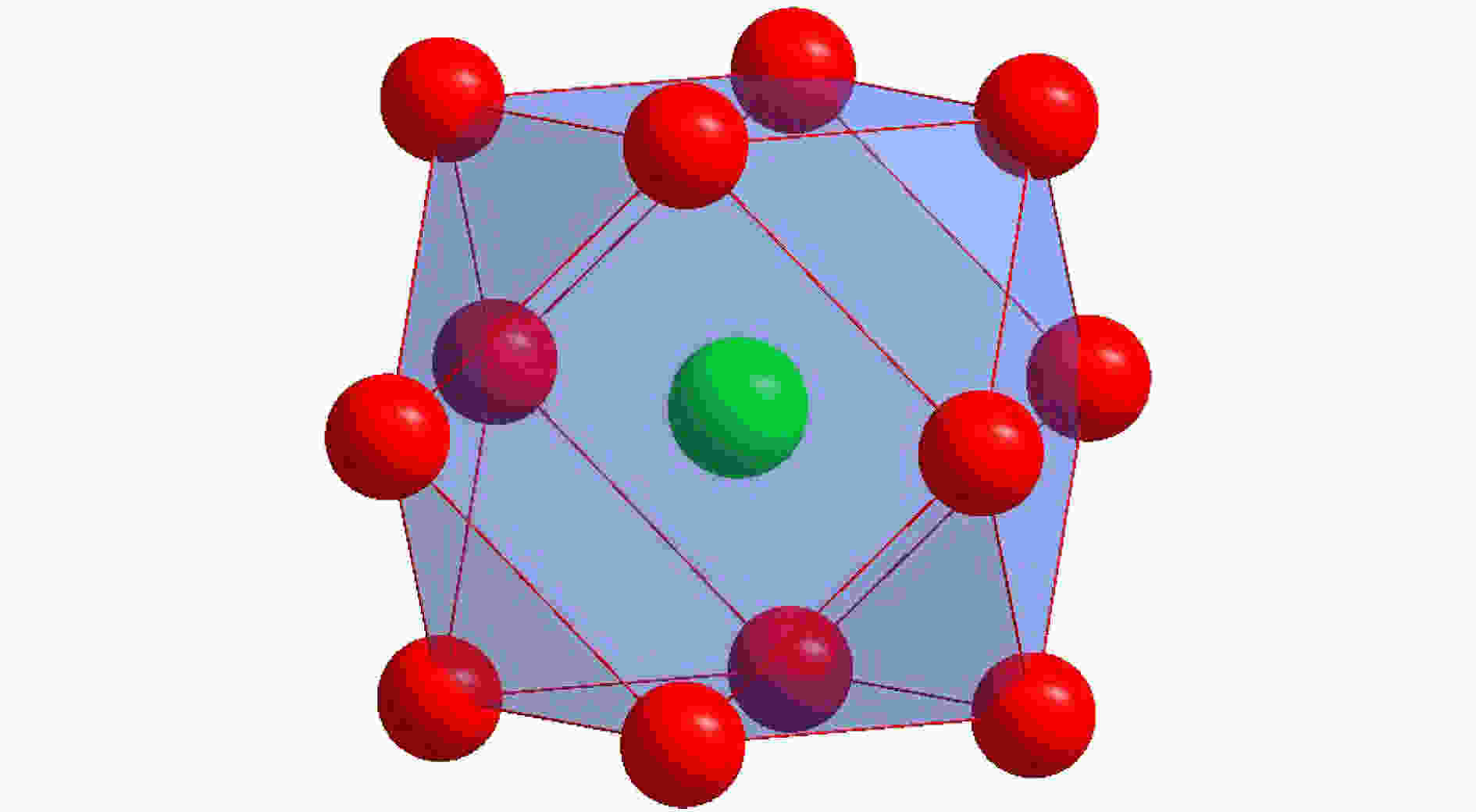
2019, 68 (6): 062101.
doi:10.7498/aps.68.20181030
Abstract +
Having a
$\gamma /\gamma′ $
microstructure similar to Ni-base superalloys and also including various alloying elements such as Al and W, new Co-base superalloy, namely Co-Al-W-base alloy, has been widely studied as a kind of potential alternative of Ni-base superalloy, which is the most important high-temperature structural material in industrial applications. Besides, Co-Al-W-base alloy has also excellent mechanical properties, for example, creep properties comparable to those of the first-generation Ni-base single crystal superalloys. In our previous work, the ideal composition formula of Ni-base superalloy has been obtained by applying the cluster-plus-glue-atom structure model of faced centered cubic solid solution, which shows that the most stable chemical short-range-order unit is composed of a nearest-neighbor cluster and three next-neighbor glue atoms. In this paper, the ideal cluster formula of Co-Al-W-base superalloy is addressed by using the same approach. Based on cluster-plus-glue-atom model theory, according to lattice constants and atom radii, calculations are carried out. The results show that the atom radius of Al is equal to Covalent radius (0.126 nm) and for
$\gamma′ $
phase the atom radius of W changes obviously (0.1316 nm). After analyzing atomic radii, the chemical formula for Co-Al-W ternary alloy is calculated to be [Al-Co12](Co,Al,W)3, which signifies an Al centered atom and twelve Co nearest-neighbored cluster atoms plus three glue atoms, which is in good consistence with that for Ni-base single crystal superalloy. For multi-element alloy, the alloying elements are classified, according to the heat of mixing between the alloying elements and Co as well as partition behavior of alloying elements, as solvent elements-Co-like elements
$\overline {{\rm{Co}}} $
(Co, Ni, Ir, Ru, Cr, Fe, and Re) and solute elements-Al-like elements
$\overline {{\rm{Al}}} $
(Al, W, Mo, Ta, Ti, Nb, V, etc.). The solvent elements can be divided into two kinds according to partition behaves:
${\overline {{\rm{Co}}} ^{\gamma }}$
(Cr, Fe, and Re) and
${\overline {{\rm{Co}}} ^{\gamma′}}$
(Ni, Ir, and Ru). The latter is further grouped into Al,
${\overline {\rm{W}} }$
(W and Mo, which have weaker heat of mixing than Al-Co ) and
${\overline {{\rm{Ta}}} }$
(Ta, Ti, Nb, V, etc., which have stronger heat of mixing than Al-Co). Then all chemically complex Co-Al-W-base superalloys are simplified into
$\overline {{\rm{Co}}} \text{-} \overline {{\rm{Al}}} $
pseudo-binary or
$\overline {{\rm{Co}}} \text{-} {\rm{Al}} \text{-} \left( {\overline {\rm{W}},\overline {{\rm{Ta}}} } \right)$
pseudo-ternary system. Within the framework of the cluster-plus-glue-atom formulism and by analyzing the compositions of alloy, it is shown that the Co-Al-W-base superalloy satisfies the ideal formula
$\left[ {\overline {{\rm{Al}}} \text{-} {{\overline {{\rm{Co}}} }_{12}}} \right]\left( {{{\overline {{\rm{Co}}} }_{1.0}}{{\overline {{\rm{Al}}} }_{2.0}}} \right)$
(or
$\left[ {{\rm{Al}} \text{-} {{\overline {{\rm{Co}}} }_{12}}} \right]{\overline {{\rm{Co}}} _{1.0}}{\rm{A}}{{\rm{l}}_{0.5}}{\left( {\overline {\rm{W}},\overline {{\rm{Ta}}} } \right)_{1.5}}$
=
${\overline {{\rm{Co}}} _{81.250}}{\rm{A}}{{\rm{l}}_{9.375}}{\left( {\overline {\rm{W}},\overline {{\rm{Ta}}} } \right)_{9.375}}$
at.%). In the same way, those of
$\gamma $
and
$\gamma′ $
phases are respectively
$\left[ {\overline {{\rm{Al}}} \text{-} {{\overline {{\rm{Co}}} }_{12}}} \right]\left( {{{\overline {{\rm{Co}}} }_{1.5}}{{\overline {{\rm{Al}}} }_{1.5}}} \right)$
(or
$\left[ {{\rm{Al}} \text{-} {{\overline {{\rm{Co}}} }_{12}}} \right]{\overline {{\rm{Co}}} _{1.5}}{\rm{A}}{{\rm{l}}_{0.5}}{\left( {\overline {\rm{W}},\overline {{\rm{Ta}}} } \right)_{1.0}}$
=
${\overline {{\rm{Co}}} _{84.375}}{\rm{A}}{{\rm{l}}_{9.375}}{\left( {\overline {\rm{W}},\overline {{\rm{Ta}}} } \right)_{6.250}}$
at.%) and
$\left[ {\overline {{\rm{Al}}} \text{-} {{\overline {{\rm{Co}}} }_{12}}} \right]\left( {{{\overline {{\rm{Co}}} }_{0.5}}{{\overline {{\rm{Al}}} }_{2.5}}} \right)$
(or
$\left[ {{\rm{Al}} \text{-} {{\overline {{\rm{Co}}} }_{12}}} \right]{\overline {{\rm{Co}}} _{0.5}}{\rm{A}}{{\rm{l}}_{0.5}}{\left( {\overline {\rm{W}},\overline {{\rm{Ta}}} } \right)_{2.0}}$
=
${\overline {{\rm{Co}}} _{78.125}}{\rm{A}}{{\rm{l}}_{9.375}}{\left( {\overline {\rm{W}},\overline {{\rm{Ta}}} } \right)_{12.500}}$
at.%). For example, alloy Co82Al9W9and its
$\gamma $
and
$\gamma′ $
phases are formulated respectively as [Al-Co12]Co1.1Al0.4W1.4(~ [Al-Co12]Co1.0Al0.5W1.5), [Al-Co12]Co1.6Al0.4W1.0(~ [Al-Co12]Co1.5Al0.5W1.0), and [Al-Co12]Co0.3Al0.5W2.2(~[Al-Co12]Co0.5Al0.5W2.0).
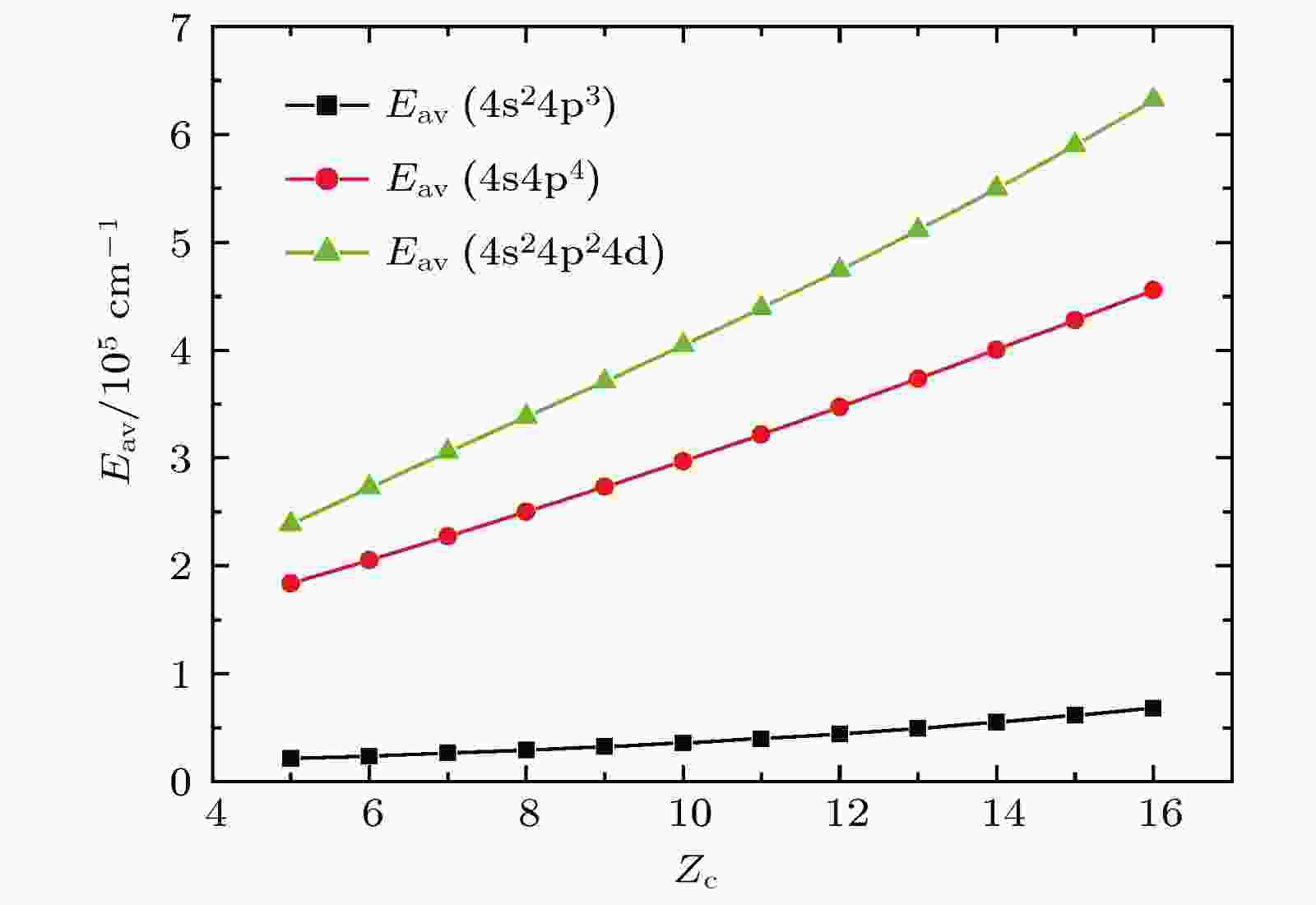
2019, 68 (6): 063101.
doi:10.7498/aps.68.20181976
Abstract +
Ions from Rh XIII to Cd XVI belong to the arsenic isoelectronic sequence ions. Their ground configuration is 4s24p3, and the lower excited configurations are 4s4p4, 4s24p24d and 4s24p25s etc. The present study aims to predict the energy levels and transition data unknown in experiment for configurations 4s24p3and 4s4p4from Rh XIII to Cd XVI ions, by analyzing the trend of the variation of Slater-Condon parameters along the As-like sequence based on the experimental energy levels available in the literature. So, the theoretical analyses of fine-structure energy levels of these configurations are conducted for the sequence ions from Rb V to Cd XVI by Hartree-Fock with Relativistic correction (HFR) method in Cowan’ code. The Slater-Condon parameter values of energy levels are obtained by least-square-fit (LSF) technique for ions mentioned above with the available experimental data. For the unknown parameters, the generalized-least-square-fit (GLSF) technique is used together with the extra (or inter)-polation method. With these new parameter values, the energy levels of 4s24p3and 4s4p4, the wavelengths and oscillator strengths of the transition array 4s24p3−4s4p4are computed. This research shows that for 4s24p3, the single-configuration approximation of HFR calculation can present the satisfactory results, however, for 4s4p4, the reasonable good results can be achieved only by multi-configuration(4s4p4+ 4s24p24d) approximation, which can be verified by the obtained data. Comparing the absolute differences between observed and present LSF calculated levels’ values (including multi-configuration interaction) for the 4s4p4configuration in ions from Rb V to Mo X with the results computed in a similar Hartree-Fock single-configuration approximate method by Person and Pettersson (Person W, Pettersson S G 1984Phys. Scr.29308), we can see that the present LSF energy levels are improved substantially. For example, the LSF minimum and maximum absolute deviation value at present are 1 cm–1and 140 cm–1, respectively, much more accurate than the results presented by Person et al., which are 45 cm–1and 382 cm–1. The predicted data are in good agreement with the experimental results. For obtaining more information, the energy levels of 4s24p3and 4s4p4configurations are computed by grasp2K-DEV package in valence-valence correlation scheme, which is based on the fully relativistic multi-configuration Dirac-Hartree-Fock (MCDHF) theory. The overall MCDHF energy levels are generally in accordance with the experimental results. The data obtained in this research are expected to be used in the future relevant theoretical and experimental investigations.
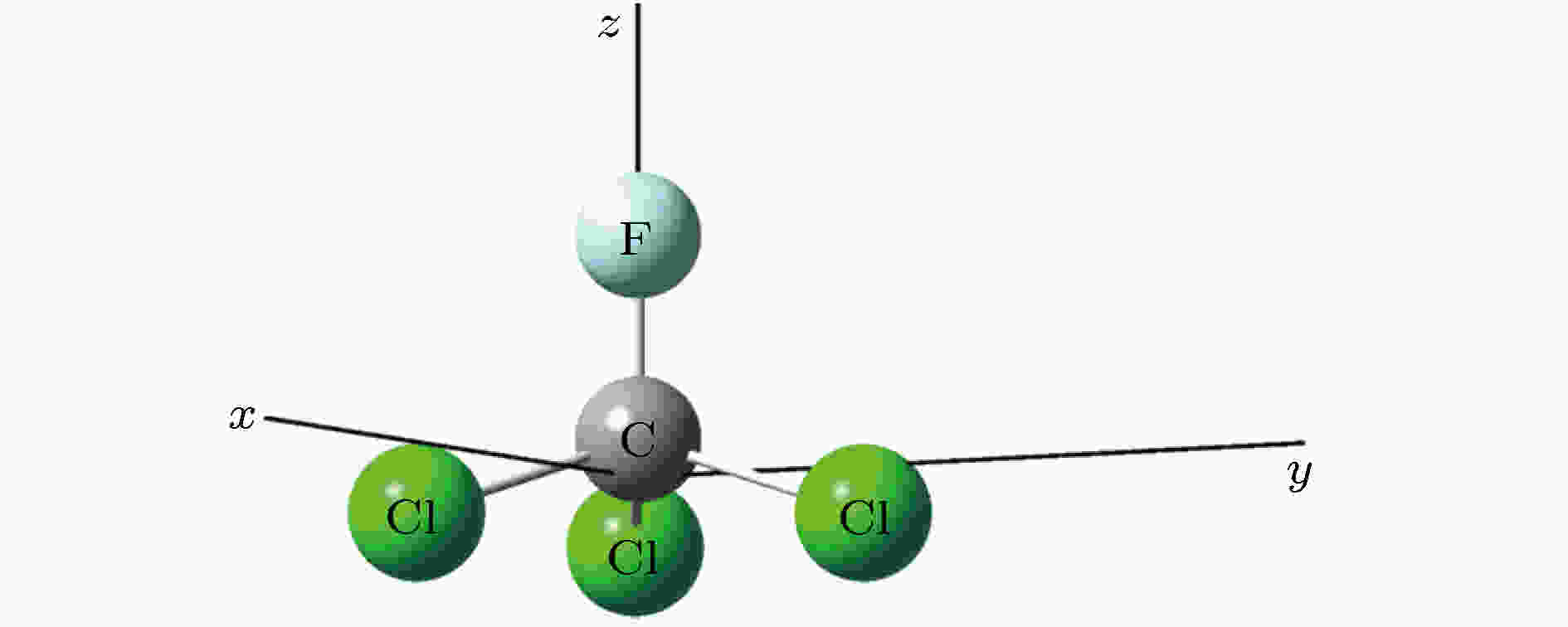
2019, 68 (6): 063102.
doi:10.7498/aps.68.20182121
Abstract +
The ozone layer in the stratosphere of the earth’s atmosphere, which can be destroyed by CFC-11 molecule, plays a crucial role in human survival because it can absorb most of the harmful radiation from the sun and effectively protect the earth’s biology. Therefore, it is of evident significance to investigate the properties of CFC-11 molecule. By Motivated by this and the adoption of B3LYP complex function at a level of 6-311++g(3df, 3pd) basis set, we carry out a series of theoretical studies of the Freon material CFC-11 (CFCl3) molecules, including the studies of the equilibrium structure, electric dipole moment, total energy, the highest occupied molecular orbital (HOMO) and the lowest unoccupied molecular orbital (LUMO) level, energy gap, infrared and Raman spectrum, C—F dissociation characteristics of CFC-11 molecule, and the effect of the applied electric field on CFC-11 molecule as well. The results show that the maximum error between the theoretical calculation value and the experimental value is less than 2% for an optimized ground state structure; the C—F bond length and C—Cl bond length extend with the increase of electric field intensity, but the degree of change of C—F bond length is much stronger than that of C—Cl; the HOMO energy level and total energy go up and then come down as the external field rises, while the LUMO energy level goes up as the field increases. The energy gapEgfirst increases and then decreases with the variation ofEHandEL. The dipole moment without electric field is a minimum value, and the external electric field leads the molecular polarity to increase and the molecular activity to strengthen. The electric field influences the absorption intensity of infrared and Raman spectrum. The infrared and Raman spectrum move toward the long wave under the action of positive electric field, while they move toward the short wave under the action of negative electric field. The red- or blue-shift of infrared and Raman spectrum occur with the change of electric field. The electric field can be adopted as an auxiliary means to separate the overlapping or quasi-overlapping spectral lines. The potential well depth decreases with the increase of the reverse electric field until it vanishes, which causes the bound state ability of C—F bond of CFC-11 molecule to gradually degrade. This paper is expected to provide a feasible and effective tunable means for the final dissociation and degradation of CFC-11 molecules.
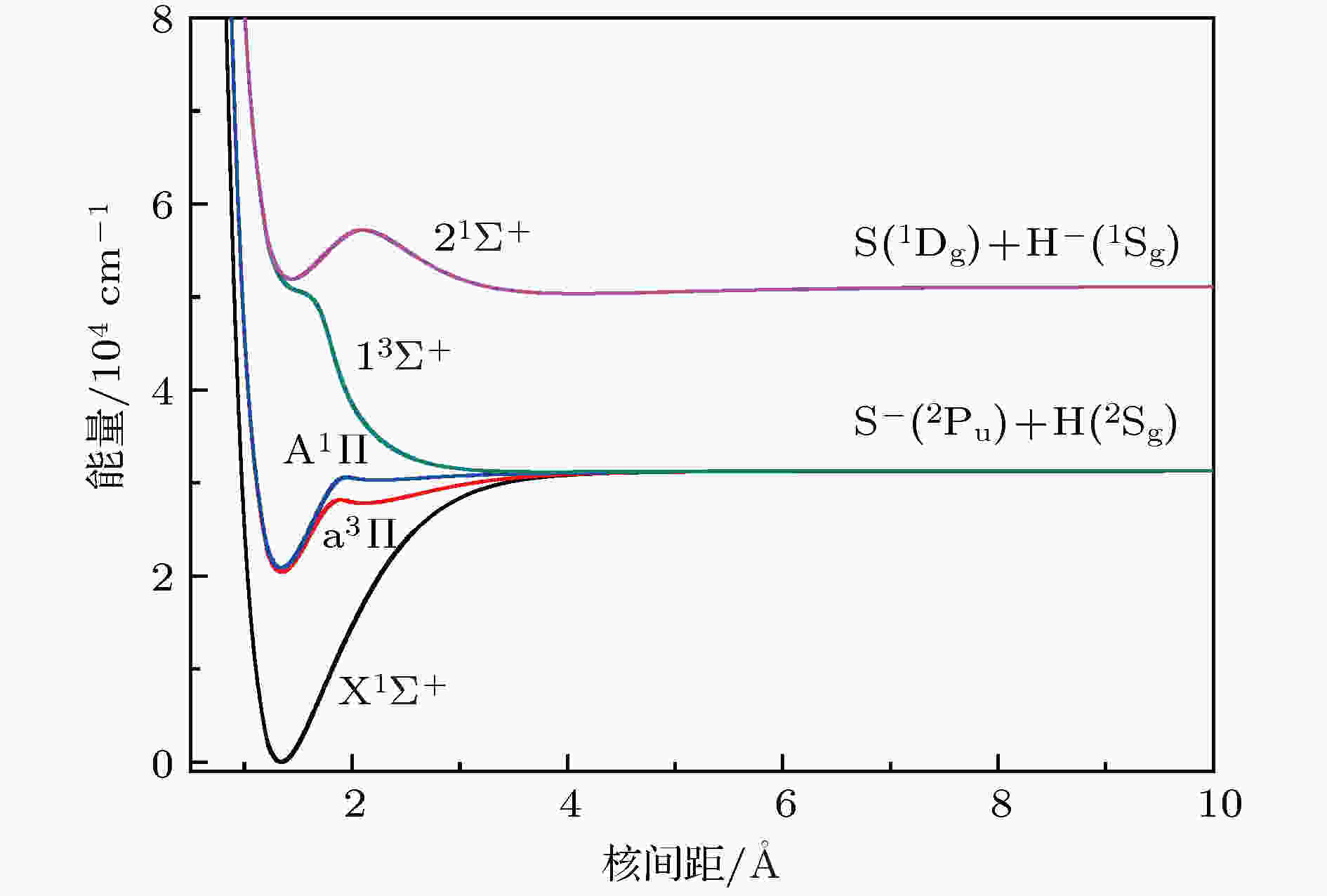
2019, 68 (6): 063103.
doi:10.7498/aps.68.20182039
Abstract +
The potential energy curves, dipole moments, and transition dipole moments for the
${{\rm{X}}^1}{\Sigma ^ + }$
,
${{\rm{a}}^3}\Pi $
, and
${{\rm{A}}^1}\Pi $
electronic state of sulfur hydride anion (SH–) are calculated by using the multi-reference configuration interaction method plus Davidson corrections (MRCI+Q) with all-electron basis set. The scalar relativistic corrections and core-valence correlations are also considered. In the CASSCF calculations, H(1s) and S(3s3p4s) shells are chosen as active space, and the rest orbitals S(1s2s2p) as closed-shell. In the MRCI+Qcalculations, the S(1s2s2p) shells are used for the core-valence correlation. Spectroscopic parameters, Einstein spontaneous emission coefficient, Franck-Condon factors, and spontaneous radiative lifetimes are obtained by using Le Roy’s LEVEL8.0 program. The calculated spectroscopic parameters are in good agreement with available experimental data and theoretical values. Spin-orbit coupling (SOC) effects are evaluated with Breit-Pauli operators at the MRCI+Qlevel. Transition dipole moments (TDMs) for the
${{\rm{A}}^1}{\Pi _1} \leftrightarrow {{\rm{X}}^1}\Sigma _{{0^ + }}^ + $
,
${{\rm{a}}^3}{\Pi _{{0^ + }}} \leftrightarrow {{\rm{X}}^1}\Sigma _{{0^ + }}^ + $
,
${{\rm{a}}^3}{\Pi _1} \leftrightarrow {{\rm{X}}^1}\Sigma _{{0^ + }}^ + $
,
${{\rm{A}}^1}{\Pi _1} \leftrightarrow {{\rm{a}}^3}{\Pi _{{0^ + }}}$
and
${{\rm{A}}^1}{\Pi _1} \leftrightarrow {{\rm{a}}^3}{\Pi _1}$
transitions are also calculated. The strength for the
${{\rm{A}}^1}{\Pi _1} \leftrightarrow {{\rm{X}}^1}\Sigma _{{0^ + }}^ + $
is the strongest in these five transitions, the value of TDM atReis –1.3636 D. We find that the value of TDM for the
${{\rm{a}}^3}{\Pi _1} \leftrightarrow {{\rm{X}}^1}\Sigma _{{0^ + }}^ + $
transition atReis 0.5269 D. Therefore, this transition must be taken into account to build the scheme of laser-cooled SH–anion. Highly diagonally distributed Franck-Condon factorf00for the
${{\rm{a}}^3}{\Pi _1}(\nu ' = 0) \leftrightarrow {{\rm{X}}^1}\Sigma _{{0^ + }}^ + $
$ (\nu '' = 0)$
transition is 0.9990 and the value for the
${{\rm{A}}^1}{\Pi _1}(\nu ' = 0) \leftrightarrow {{\rm{X}}^1}\Sigma _{{0^ + }}^ + (\nu '' = 0)$
transition is 0.9999. Spontaneous radiative lifetimes of
$\tau \left( {{{\rm{a}}^3}{\Pi _1}} \right)= 1.472 \;{\text{μ}}{\rm{s}}$
and
$\tau \left( {{{\rm{A}}^1}{\Pi _1}} \right)=0.188 \;{\text{μ}}{\rm{s}}$
are obtained, which can ensure that laser cools SH–anion rapidly. To drive the
${{\rm{a}}^3}{\Pi _1} \leftrightarrow {{\rm{X}}^1}\Sigma _{{0^ + }}^ + $
and
${{\rm{A}}^1}{\Pi _1} \leftrightarrow {{\rm{X}}^1}\Sigma _{{0^ + }}^ + $
transitions, just one laser wavelength is required. The wavelengths are 492.27 nm and 478.57 nm for two transitions, respectively. Notably, the influences of the intervening states
${{\rm{a}}^3}{\Pi _1}$
and
${{\rm{a}}^3}{\Pi _{{0^{\rm{ + }}}}}$
on the
${{\rm{A}}^1}{\Pi _1} \leftrightarrow {X^1}\Sigma _{{0^ + }}^ + $
transition are small enough to implement a laser cooling project. A spin-forbidden transition and a three-electronic-level transition optical scheme of laser-cooled SH–anion are constructed, respectively. In addition, the Doppler temperatures and recoil temperatures for the
${{\rm{a}}^3}{\Pi _1} \leftrightarrow {{\rm{X}}^1}\Sigma _{{0^ + }}^ + $
and
${{\rm{A}}^1}{\Pi _1} \leftrightarrow {{\rm{X}}^1}\Sigma _{{0^ + }}^ + $
transitions of laser-cooled SH–anion are also obtained, respectively.

2019, 68 (6): 064201.
doi:10.7498/aps.68.20182004
Abstract +
Photonic spin Hall effect is generally described as a spin-dependent splitting. Previous studies have focused on the transverse spin-dependent splitting of light field. In this work, a method of manipulating the longitudinal photonic spin Hall effect which is based on dynamic and Pancharatnam-Berry phase is proposed. The theoretical analysis demonstrates that the lens group consisting of a Pancharatnam-Berry phase lens and a dynamic lens has two spin-dependent foci. Firstly, because Pancharatnam-Berry phase is spin-dependent, the left- and right-handed circularly polarized component can respectively acquire a Pancharatnam-Berry phase with opposite sign when a linearly polarized light beam passes through the Pancharatnam-Berry phase lens with phase retardation
${\text{π}}$
. It leads one circularly polarized component to be focused and the other diverged. This is essentially the spin-dependent splitting of light field in momentum space, which is caused by Pancharatnam-Berry phase. And then, an ordinary lens is inserted behind the Pancharatnam-Berry phase lens to introduce a dynamic phase modulation. Due to dynamic phase being spin-independent, the constructed lens group can focus the photons with different spin states at different focal points longitudinally under the appropriate conditions. In other words, the lens group has two spin-dependent focal points. The two focal points split the photons with different spin states in the longitudinal direction. The longitudinal spin-dependent splitting is dependent on the focal lengths of the two lens and the distance between the two lenses. By changing the three parameters, arbitrary longitudinal spin-dependent splitting can be obtained. Lastly, an experimental system is set up to verify the theoretical results. The relationship between the spin-dependent splitting and the distance between the two lenses is measured. By introducing a Glan laser polarizer and a quarter wave-plate, the circularly polarized chirality of the light field at the focal point is also measured. These experimental results are all in good agreement with the theoretical analyses. These results are helpful in understanding the physical origin of photonic spin Hall effect and developing novel photonic devices based on photonic spin Hall effect.

2019, 68 (6): 064202.
doi:10.7498/aps.68.20181886
Abstract +
Single-pixel imaging is a computational imaging scheme that offers novel solutions for multi-spectral imaging, feature-based imaging, polarimetric imaging, three-dimensional imaging, holographic imaging, and optical encryption. The single-pixel imaging scheme can be used for imaging in wave band such as infrared and micro wave imaging, or will be useful in the case where the array detector technique is difficult to meet the requirement such as the sensitivity or the volume. The main limitation for its application comes from a trade-off between spatial resolution and acquisition time, in other words, from relatively high measurement and reconstruction time. Although compressive sensing technique can be used to improve the acquisition time by reducing the number of samplings, the computational time to reconstruct an image is not fast enough to satisfy the real-time video. In this paper, we propose to reduce the required signal acquisition time by using a novel sampling scheme based on optimized ordering of the Hadamard basis, and improve the image reconstruction efficiency by using fast Walsh-Hadamard transform. In our method, the Hadamard basis is rearranged in the ascendant order of the values of its " sparsity” coefficients which are obtained through " Daubechies wavelets 1 (Haar wavelets)”, " Daubechies wavelets 2” wavelet transform and discrete cosine transform, and then compute each total sum of the transformed coefficients’ absolute value, respectively. The measurement order of the Hadamard basis is then rearranged directly according to Walsh order and random permutation order. The peak signal-to-noise ratio (PSNR) and structural similarity index (SSIM) of the retrieved images are computed and compared to test all the five reordering schemes above both in our numerical simulation and outdoor experiments. We find that the reordering method based on Haar wavelet transform is the best PSNR and SSIM and it can reconstruct image under a sampling ratio of 25% which corresponds to the recovering time in which 300 frame per second @64 × 64 pixels single-pixel imaging can be achieved. The optimized measurement order of Hadamard basis greatly simplifies post processing, resulting in significantly faster image reconstruction, which steps further toward high frame rate single-pixel imaging’s applications. Moreover, we propose a novel method to optimize measurement basis in single-pixel imaging, which may be useful in other basis optimizing, such as optimized random speckles, etc.

2019, 68 (6): 064203.
doi:10.7498/aps.68.20181844
Abstract +
As a new technique of photomicrography of complex optical field, the Fresnel incoherent correlation holography (FINCH) is particularly attractive in recent years because of its incoherent optical recording characteristics. For a new image recording and reconstruction system, a key concern is how to configure the experimental layout of FINCH by using available optical elements to achieve optimal resolution. However, in previous reports, there exist different viewpoints about this issue, and the imaging conditions of the best resolution remain to be clarified. As is well known, the imaging resolution is affected by the effective aperture of hologram and the change of the recording distance between spatial light modulator (SLM) and image sensor (CCD) can cause the hologram aperture to change. In the FINCH system the effective aperture of hologram is related not only to the aperture influence of each element used in the recording system, but also to the overlapping area of interference between the signal and reference wave and the pixel spacing of the image sensor. In previous reports, the researchers mainly used the ray-tracing method to discuss the effective aperture radius of hologram by ignoring the influences of the diffraction of light wave and the pixel spacing size of image sensor on the aperture of hologram. Based on the theories of wave optics we carry out a thorough investigation into the effective aperture of FINCH. We find that the pixelization of the image sensor, e.g. CCD, is a decisive factor influencing the resolution of FINCH, and we adopt numerical simulations and optical experiments to further verify the theoretical conclusions that the optimal lateral resolution of FINCH is achieved only if the recording distance (Zh) is equal to the focal length (fd) of diffractive lens displayed on a spatial light modulator; the resolution is deteriorated with the increase of
$\left| {{Z_{\rm{h}}} - {f_{\rm{d}}}} \right|$
. From the viewpoint of Fourier optics, the smaller the imaging distance
$\left| {{Z_{\rm{h}}} - {f_{\rm{d}}}} \right|$
, the larger the aperture angle of hologram (
$ \approx {{{R_{\rm{h}}}} / {\left| {{Z_{\rm{h}}} - {f_{\rm d}}} \right|}}$
), the higher the collected spatial frequency is, hence, the higher the lateral resolution is. On the other hand, although the FINCH overcomes the spatial coherence limitation, it requires temporally coherent or quasi-monochromatic light. Our study also indicates that the requirements for the spatiotemporal coherence can be eased when the CCD is located at the focal plane of diffractive lens.
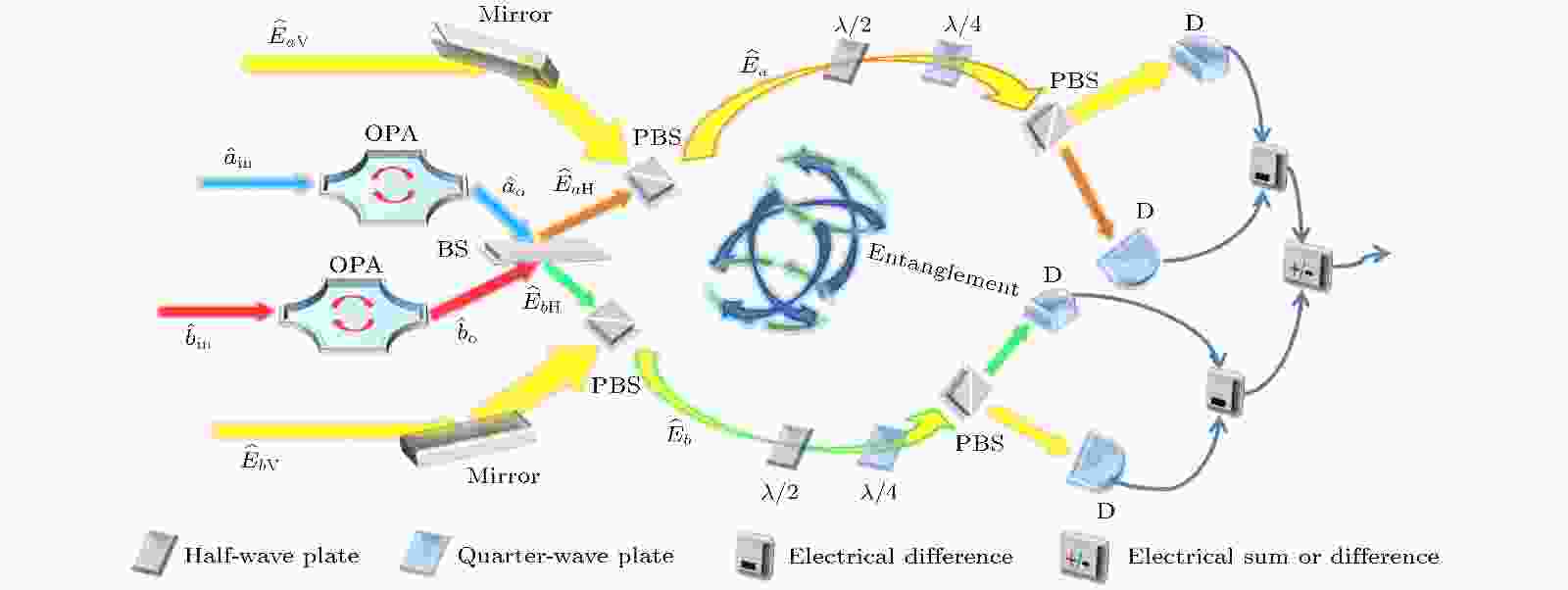
2019, 68 (6): 064204.
doi:10.7498/aps.68.20181911
Abstract +
As a widely utilized information carrier, polarization microwave shows plenty of merits. Quantum microwave is booming gradually due to the development of superconducting technology, which makes it a promising potential to apply quantum entanglement to polarization microwave. In this paper, we introduce the concept of continuous variable polarization entanglement. Meanwhile, a scheme of polarization entanglement in microwave domain is proposed and simulated. The detail derivations are given and discussed. Polarization entangled microwaves are prepared by combining quadrature entangled signals and strong coherent signals on polarization beam splitters, and quadrature entangled signals are prepared by utilizing Josephson mixer. In order to probe the polarization entanglement between output signals, inseparability of Stokes vectors
$I({\hat S_1},{\hat S_2})$
and
$I({\hat S_2},{\hat S_3})$
, is analyzed in 100 MHz operation bandwidth of Josephson mixer. The relation between inseparabilityIand squeezing degreerand between inseparabilityIand amplitude ratioQare analyzed respectively. The results show that
$I({\hat S_1},{\hat S_2})$
is sensitive to the variation ofQ, while
$I({\hat S_2},{\hat S_3})$
is sensitive to the change ofr. The physical reasons for these results are explored and discussed. Apart from these,
$I({\hat S_1},{\hat S_2})$
remains its value above 1 under the condition in this paper, but on the contrary,
$I({\hat S_2},{\hat S_3})$
keeps its value well below 1. It proves that
${\hat S_2}$
and
${\hat S_3}$
of Stokes vectors are inseparable from each other, thus output signals
${\hat E_a}$
and
${\hat E_b}$
of our scheme exhibit bipartite entanglement. The best entanglement appears nearly at about 70 MHz, at this point the minimum
$I({\hat S_2},{\hat S_3})$
value is 0.25.

EDITOR'S SUGGESTION
2019, 68 (6): 064205.
doi:10.7498/aps.68.20182079
Abstract +
Entanglement source with high entanglement degree is the guarantee for accomplishing the quantum information transmission and process with higher fidelity. Continuous variable Einstein-Podolsky-Rosen (EPR) entangled optical field with quantum correlation of amplitude and phase quadrature is a basic and important quantum resource in the quantum information science area, which can be obtained by a non-degenerate optical parametric amplifier (NOPA) operated below the threshold pump power. Because of the limitation of the imperfect performance of optical components in optical cavity, we should find efficient methods of implementing quantum manipulation to improve the entanglement degree of the entangled state of light. Connecting NOPA1 and NOPA2 in series, the entangled state of light output from the NOPA1 can be manipulated by NOPA2, and the entanglement degree can be enhanced under certain conditions. To improve the entanglement degree to a greater extent, the structure of the NOPA1 is chosen as a half-monolithic standing-wave optical resonator with the triple resonance of the pump and two subharmonic modes. The NOPA1 is able to output the entangled optical fields with an entanglement degree of 8.4 dB, which is the highest entanglement generated by a single device so far. The structure of the NOPA2 can be chosen as a standing-wave optical cavity or a four-mirror ring optical cavity. According to the different structures of the NOPA2, we theoretically design two kinds of optical systems with two cascaded cavities and compare the effects of the two optical systems on the continuous variable EPR entanglement cascaded enhancement in detail. Based on the above contrastive analysis, when the entanglement degree of the input optical fields is 8.4 dB and the transmissivity of the output coupler is lower, the structure of a four-mirror ring optical cavity for NOPA2 cannot enhance the entanglement degree, so the optical system including NOPA2 with standing wave cavity structure and the optical isolator with high transmission efficiency is appropriate. When the transmissivity of the output coupler and transmission efficiency of the optical isolator are higher, the structure of the NOPA2 should be chosen as a standing-wave optical cavity, otherwise the structure of the NOPA2 should be chosen as a four-mirror ring optical cavity. We also theoretically analyze the dependence of the correlation degree of output optical fields on physical parameters. The results show that under the conditions of higher input and output coupling efficiency, higher transmission efficiency and lower intro-cavity loss, the entangled state of light with higher entanglement degree can be obtained experimentally. This provides the reference for obtaining entangled optical fields with higher entanglement degree in the future.
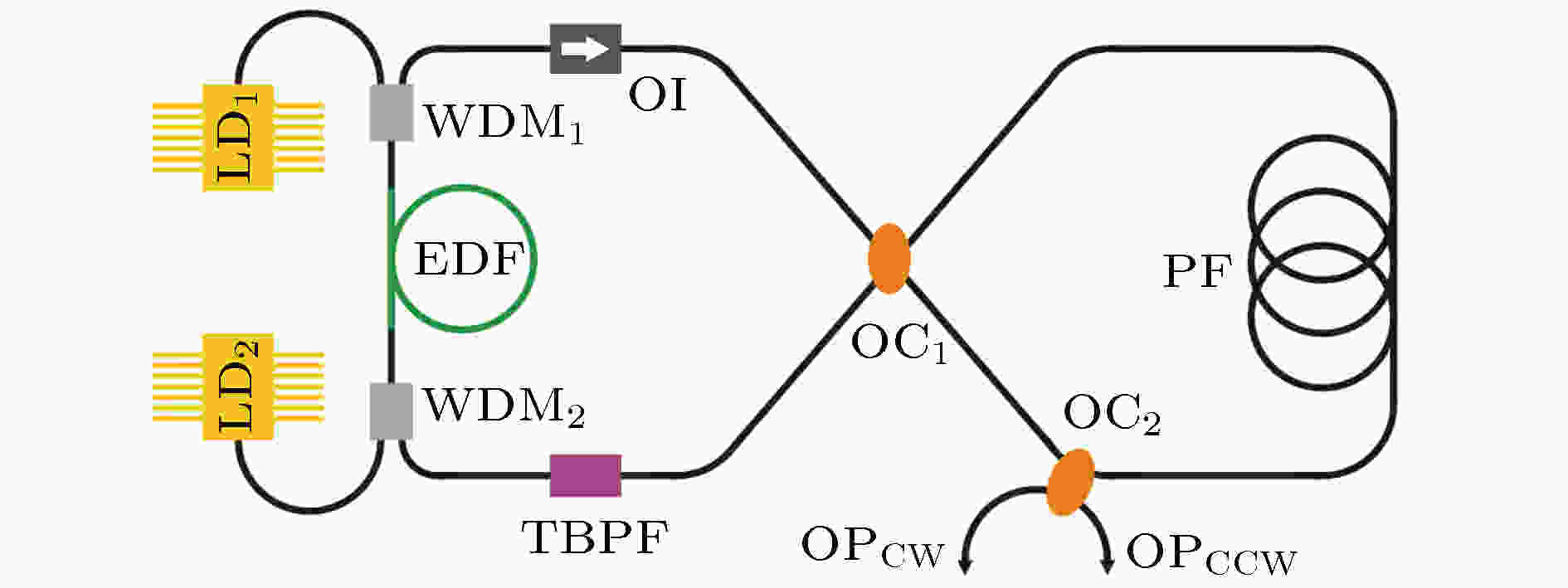
2019, 68 (6): 064206.
doi:10.7498/aps.68.20182144
Abstract +
Over the last decades, passive mode-locked fiber laser has received considerable attention because of ultrashort pulse, compactness, and low cost. As a saturable absorber, nonlinear optical loop mirror (NOLM) has shown the advantages of high damage threshold, possibility of all-PM fiber implementation, short response time and therefore potentially low intrinsic noise. Spectral filtering plays an important role in NOLM mode locked fiber laser, but the influence of filtering parameters on mode locking operation is rarely reported. In this paper, the influence of filtering bandwidth on mode locking operation and on output pulse characteristics are experimentally investigated. A 2 × 2 optical coupler with a splitting ratio of 10 : 90 is introduced at one end of fiber loop to form a loss-imbalanced NOLM, and extracts 90% of intracavity pulse energy as outputs. With this architecture, an all polarization-maintaining figure-8 Er-doped fiber ultrafast laser is achieved. A home-made bandwidth and wavelength tunable bandpass filter is utilized in the cavity, and the filtering bandwidth is defined by 10 dB bandwidth. The clockwise and counter-clockwise mode locked output power are 8.4 mW and 8.6 mW, respectively, with a repetition rate of 2.734 MHz. With a spectral bandwidth of 2.1 nm, the intracavity pulse is shaped by spectral filtering and soliton effect. The 3 dB bandwidth of the clockwise and counter-clockwise mode locked output pulse are 10.1 nm and 1.8 nm, and the values of corresponding full width at half maximum (FWHM) of the direct outputs are 583.7 fs and 2.94 ps, respectively. As the filtering bandwidth increases, the role of filter in spectral shaping weakens, and the parameters of two output pulses become close. When spectral bandwidth is larger than 7.3 nm, the intracavity pulse is shaped by gain spectrum and soliton effect. Both of the clockwise and counter-clockwise output pulses become the transform-limited pulses with almost the same FWHMs of 440 fs. Besides, the wavelength of the figure-8 fiber laser can be adjusted in a range larger than 30 nm by modulating the wavelength of the filter. The tunable mode-locked fiber laser has great potential applications in various application fields.
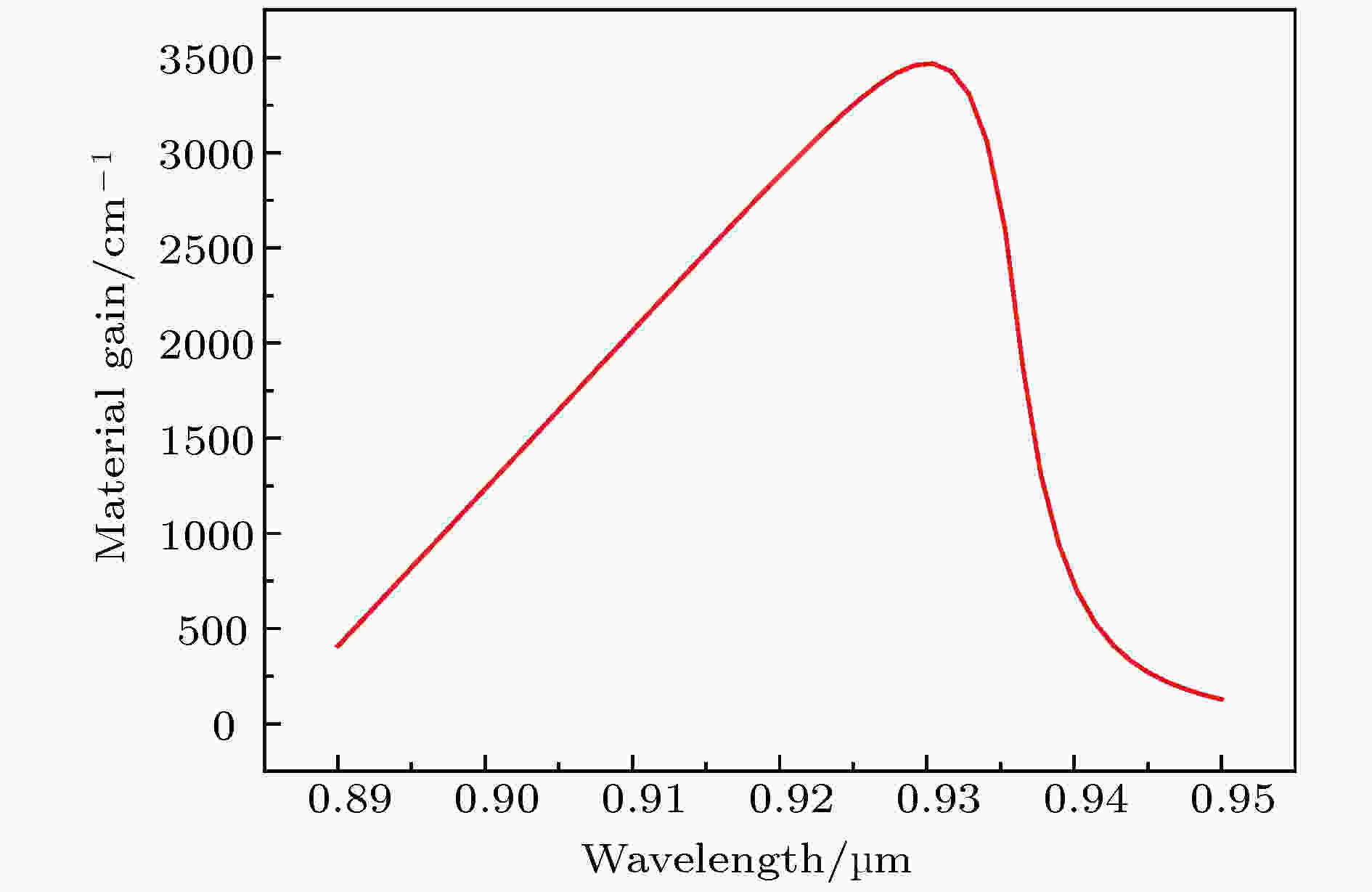
2019, 68 (6): 064207.
doi:10.7498/aps.68.20181822
Abstract +
A high slope efficiency vertical-cavity surface-emitting laser (VCSEL) is described. The InGaAs/GaAsP strain compensated multiple quantum wells (MQWs) are designed by PICS3D. The wavelength redshift occurs due to the thermal effect, the lasing wavelength of MQWs is designed to be around 928 nm. The active region consists of five compressively strained 4.4 nm thick In0.16Ga0.84As quantum wells separated and surrounded by 6.2 nm thick GaAs0.88P0.12tensile strained compensation layers to obtain the high quantum efficiency and ensure the stress release. Subsequently, the MQWs are grown by metal-organic chemical vapor deposition (MOCVD) and the photoluminescence (PL) spectrum is measured using an Nd:YAG laser (532 nm excitation), of which the peak wavelength is approximately 928 nm and the full width at half maximum is nearly 17.1 nm. The resonant cavity is surrounded by p- and n-DBRs. The n-DBRs are designed to be a 28-period AlAs/Al0.12Ga0.88As and 3.5-period Al0.90Ga0.10As/Al0.12Ga0.88As, and the p-DBR is designed to be a 23-period Al0.90Ga0.10As/Al0.12Ga0.88As. The thickness of each a material is
$\lambda/4n$
(
$\lambda$
= 940 nm,nrepresents refractive index), and 20 nm graded layer is inserted in the interface between two types of materials. The p-/n-DBRs’ experiment PL reflection spectra (using a white illuminant) are carried out, the central wavelength is around 938.7 nm, and the reflectivity values of p-/n-DBRs are nearly 99.0% and 99.7%, respectively. The VCSELs are grown by MOCVD technique, and treated by dry etching, wet oxidation, metal electrode technology and other processes. In the process of dry etching, the top mesa is treated by inductively coupled plasma with BCl3and Cl2chemistry. In order to expose the oxide layer the wet oxidized process is carried out, and the etching depth is nearly 3500 nm. An oxidation furnace is heated for 15 min prior to oxidation. Then the oxide aperture is shaped by the wet nitrogen oxidation furnace at 425 °C with an N2flow of 200 sccm, and the oxide rate is approximately 0.40
${\text{μm}}$
/min for A0.98Ga0.02As. The diameter of oxide aperture is made into an 8
${\text{μm}}$
diameter. In the process of metal electrode technology, AuGeNi alloy is sputtered on the top surface to form p-type ohmic contact, and Ti/Pt/Au is evaporated on the back surface of substrate to form an n-type ohmic contact. Rapid thermal annealing at 350 °C in a nitrogen atmosphere is carried out subsequently to obtain a good-quality ohmic contact. Finally, we test the VCSELs’L-I-Vcharacteristics and spectra in different areas. In area 1, room-temperature lasing at around 940 nm is achieved with a threshold current of 0.95 mA, a slope efficiency of 0.96 W/A, and an output power of 4.75 mW. In area 2, threshold current is 1 mA, a slope efficiency is 0.81 W/A at 25 °C and threshold current is 1.9 mA, slope efficiency is 0.57 W/A at 25 °C. The output power values reach up to 3.850 mW and 2.323 mW at 25 °C and 80 °C, respectively.
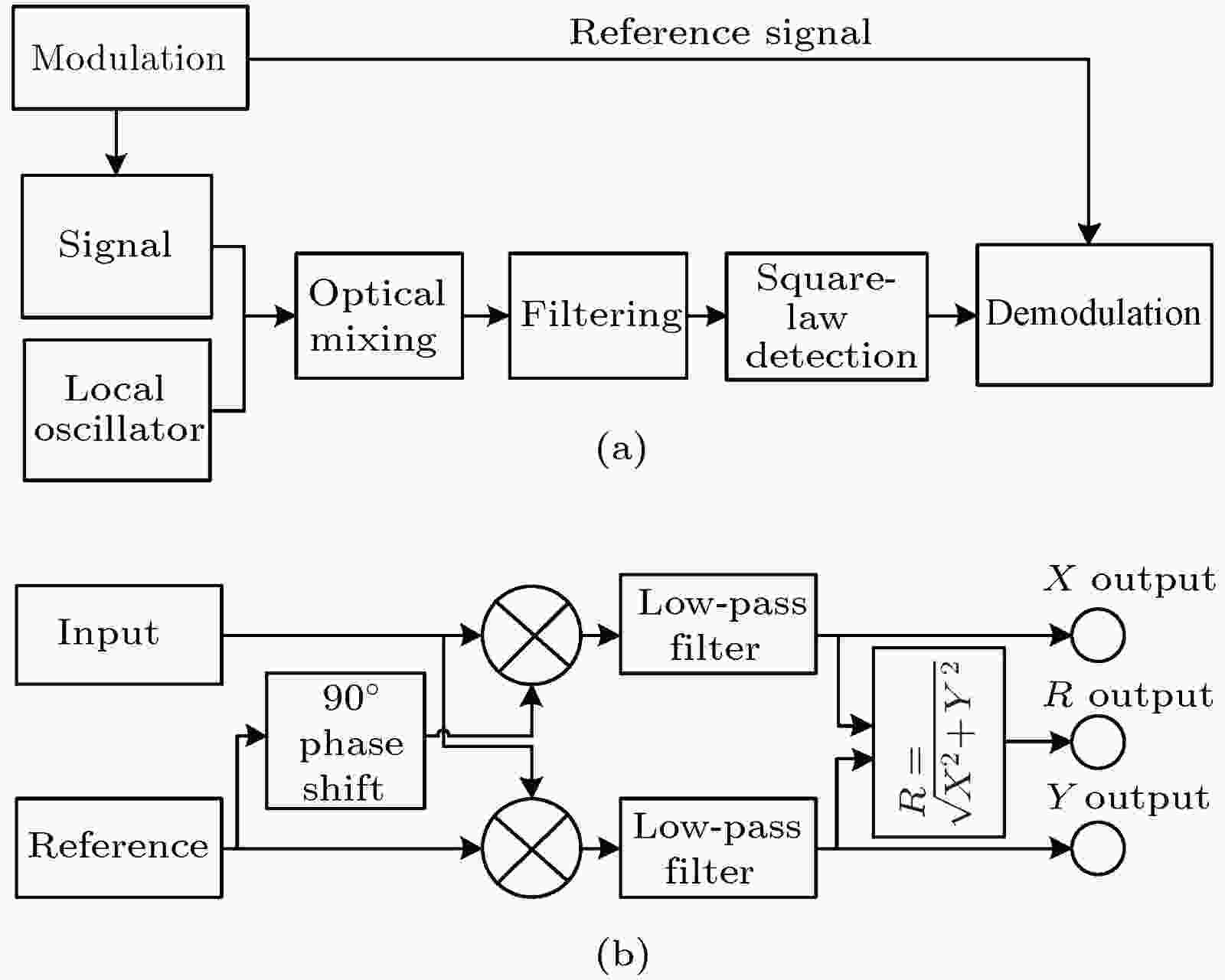
2019, 68 (6): 064208.
doi:10.7498/aps.68.20181620
Abstract +
Laser heterodyne is a kind of technique based on coherent detection with high sensitivity and spectral resolution for spectrum measurements. For these reasons, it has been widely used in many research fields, such as trace gases’ detection of earth’s or terrestrial planets’ atmosphere. However, when the laser heterodyne spectrometer is used for measuring the spectrum, the instrument line shape (ILS) function usually smooth the spectrum, which affects the inversion results of the gas column density. In previous researches, the radio frequency (RF) filter response function was usually used as the ILS, but recent studies indicated that the ILS without consideration of the influence of lock-in amplifier was not precise enough. In order to obtain the ILS function of the laser heterodyne spectrometer, the main factors which influence the ILS are analyzed, including the RF filter bandwidth, integral time and low-pass filter of lock-in amplifier, and the process is based on the principle of laser heterodyne technology and the flow of heterodyne signal processing. The presented ILS is the convolution of RF filter, wavelength variation in the integral time and the low-pass filter. In addition, for testing the effectiveness of the ILS in this paper, the laser heterodyne spectrometer which was built in our laboratory is used for the multiple measurement of the absorption of water vapor and methane in the band of 3.53
${\text{μm}}$
and the column densities are retrieved with different ILS. The experimental results show that the actual resolutions of the laser heterodyne spectrometer are about 0.005 cm–1and 0.025 cm–1when the integral times are set to be 10 ms and 100 ms respectively. Furthermore, the RF filter response function and the ILS function presented in the paper are respectively used in the procedure of water vapor and methane inversion. The results show that when the ILS function used for the retrieval, the sum of squared residual reduces about 16% and the residuals at the peak of methane absorption reduces almost 100% compared with the scenario when using the RF filter function. Above all, the comprehensive analysis of the laser heterodyne spectrometer in this paper indicates that the ILS function is more precise than pioneering studies and this work will be helpful for retrieving the precise profiles of trace gases.
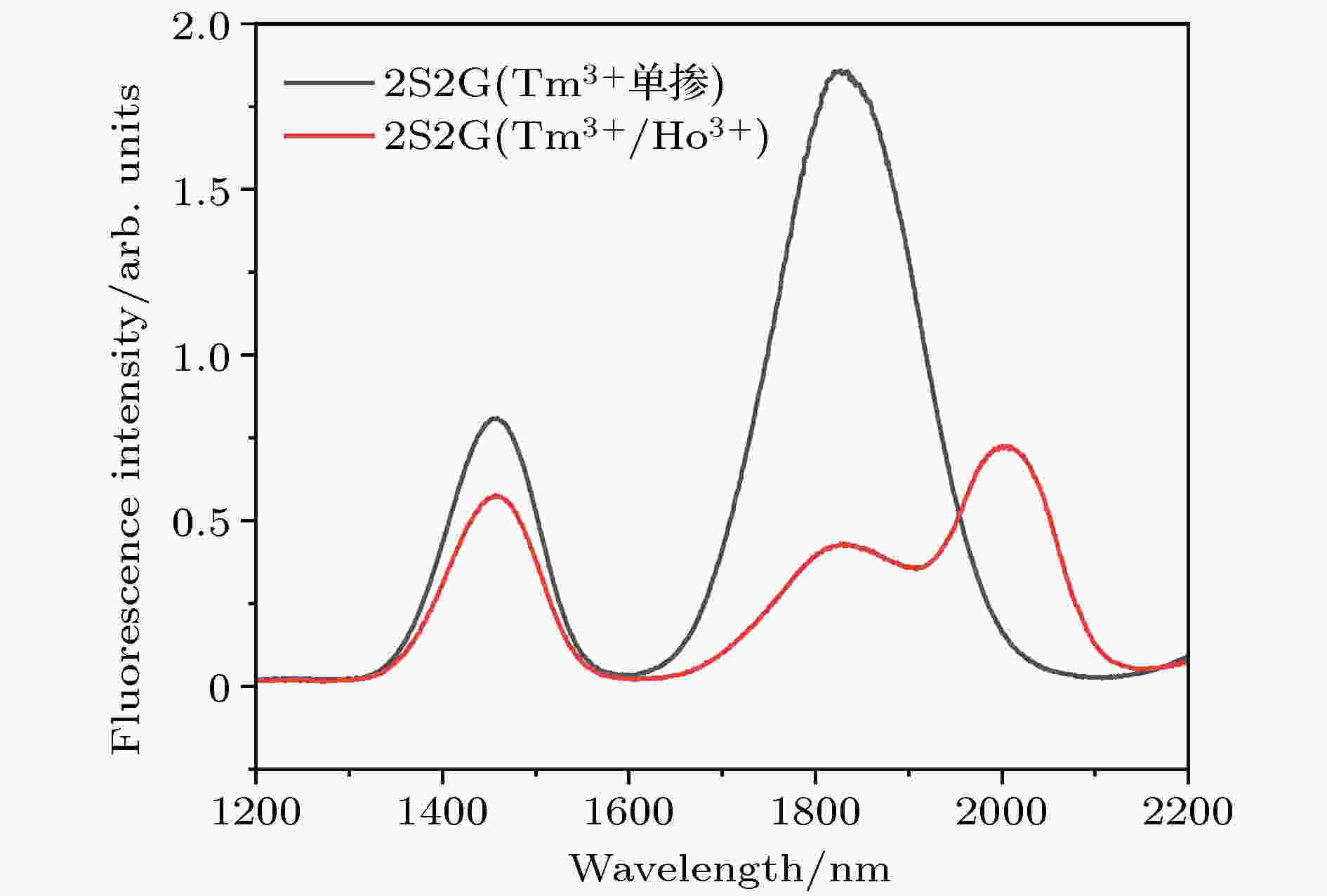
2019, 68 (6): 064209.
doi:10.7498/aps.68.20181817
Abstract +
Microsphere lasers operating at the
$2\;{\text{μ}}{\rm{m}}$
band have important applications in the fields of bio-medical sensing, laser radars, narrow linewidth optical filtering, and air-pollution monitoring. In this work, we utilize a novel type of chalcogenide glass, whose composition is Ge-Ga-Sb-S or 2S2G, to fabricate microsphere lasers. Compared with chalcogenide glasses used in previous microsphere lasers, this 2S2G glass is environmentally friendly. It also has a lower melting temperature and a higher characterization temperature, implying that 2S2G microspheres can be fabricated at lower temperatures and the crystallization problem happening in the sphere-forming process can be mitigated. A
$\text{Tm}^{3+}\text{-}\text{Ho}^{3+} $
co-doping scheme is applied to the 2S2G glass, so that fluorescence light at ~
$2\;{\text{μ}}{\rm{m}}$
can be obtained from the bulk glass. Owing to the superior properties of the 2S2G glass, we can utilize a droplet method to mass-produce hundreds of high-quality 2S2S microspheres in one experimental run. The diameters of microspheres fabricated in this work fall in a range of 50−
$250\;{\text{μ}}{\rm{m}}$
and typical quality factors (Qfactor) of microspheres are higher than 105. As a representative example, we characterize the optical properties of a
$205.82\;{\text{μ}}{\rm{m}}$
diameter 2S2G microsphere. This microsphere is placed in contact with a silica fiber taper, so that the pump light can be evanescently introduced into the microsphere and the fluorescence light can be evanescently collected from the microsphere. A commercial laser diode (808 nm) is used as a pump source and an optical spectral analyzer is used to measure the transmission spectra of the microsphere/fiber taper coupling system. Apparent whispering gallery mode patterns in the ~
$2\;{\text{μ}}{\rm{m}}$
band can be noted in the transmission spectra of the coupling system. When the pump power increases beyond a threshold of 0.848 mW, a lasing peak at 2080.54 nm can be obtained from the coupling system. Experimental results presented in this work show that this 2S2G chalcogenide glass is a promising base material for fabricating various active optical/photonic devices in the middle-wavelength and long-wavelength infrared spectra.
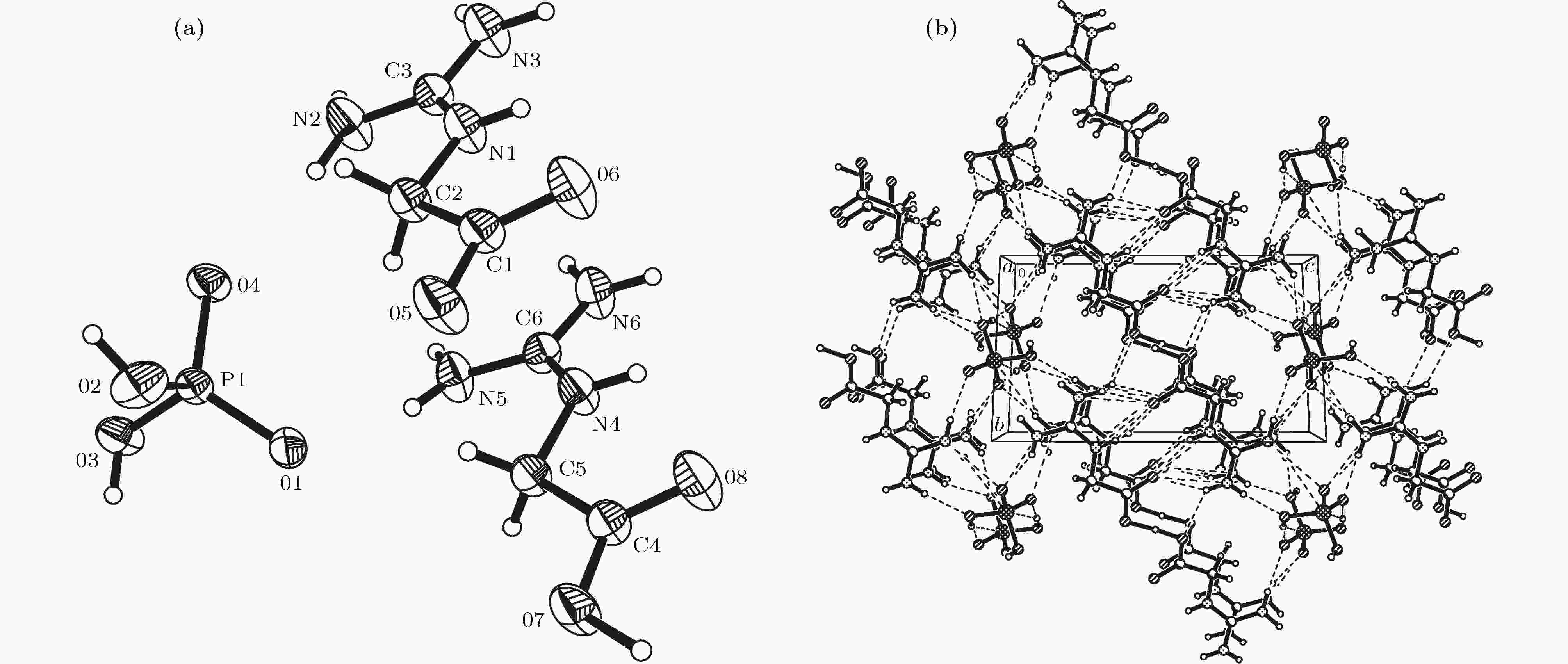
2019, 68 (6): 064210.
doi:10.7498/aps.68.20181627
Abstract +
L-arginine phosphate monohydrate (LAP) crystal is an excellent nonlinear optical material, its effective nonlinear optical coefficient is about 2−3.5 times that of potassium dideuterium phosphate (KDP) crystal, and its conversion efficiency can achieve up to 90%. The deuterated crystal of LAP has a very high laser damage threshold. Thus, once it was considered as a preferred material to replace KDP crystal for laser inertial confinement fusion and other fields. In addition, the LAP crystal has a much higher stimulated Brillouin scattering (SBS) reflectivity than quartz crystal and also has a lower SBS threshold. Moreover, it exhibits a special reversible phase-change in the variable temperature process, and shows an ultra-long spin-lattice relaxation time at solid-state NMR. In a word, the LAP crystal has shown its uniqueness under the action of energy such as light, heat and magnetic field. However, for these special phenomena, there is no reasonable explanation. Phosphate arginine is responsible for the biological energy storage and transfer in invertebrates as an important phosphorus source, which has a similar chemical composition to that of LAP crystal. The special electrostatic or hydrogen bonding interaction between guanidine and phosphate plays an important role in protein molecule interaction and their biochemical functions. Moreover, the conformational transitions of L-arginine molecule in phosphoric acid solution at different energies have been reported, and the fluorescence emission of L-arginine molecule aggregates can be changed by the interaction between phosphoate and guanidine group. The interaction between phosphoate and guanidine group in crystal structure is also studied as a model of biomolecular interaction. In order to further study the mechanism of interaction between phosphoate and guanidine group and the crystal macroscopic properties, phosphate bis-guanidinoacetate (PBGA) crystal containing the similar phosphoate and guanidine groups has been synthesized and reported. In this paper, the geometry parameters, band structure, electronic density of states, and optical properties of PBGA crystal are investigated by first-principles based the density functional theory. The energy gap of PBGA crystal is 4.77 eV, much smaller than 5.96 eV of KDP crystal. Therefore, the photon transition becomes easier and the corresponding photon absorption is relatively large in PBGA crystal. The top states of crystal valence band are mainly composed of the N-2p of guanidine and the O-2p of carboxyl and phosphate groups. There exists the electron interaction among guanidine, carboxyl and phosphate groups. The optical properties of PBGA crystal are similar in the [100] and [010] orientation, whose linear optical properties are better than those of [001] when the incident photon energy is less than 10 eV. The strong energy loss peak at 9.46 eV in the [001] orientation is due to the electronic transition of N-2p on guanidine group in the valence band, and its distribution is narrow. Thus the optical properties of [001] orientation are limited. The present research establishes a good foundation for further understanding and studying the intergroup interactions and optical properties in PBGA crystal.
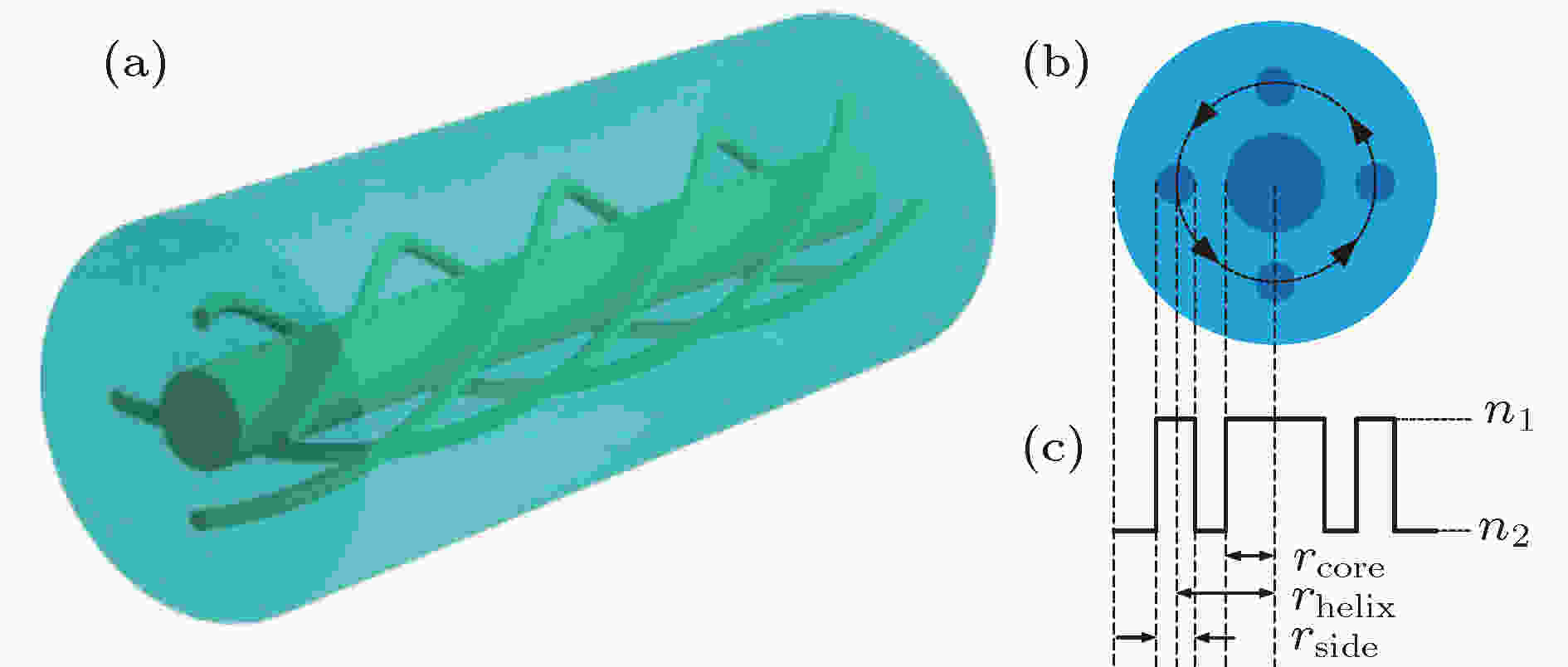
2019, 68 (6): 064211.
doi:10.7498/aps.68.20182036
Abstract +
A type of fiber-based orbital angular momentum (OAM) modulator is designed according to transformation relation between OAM beam and optical fiber vector mode, together with mode-coupling theory, which is based on the combination of multimode fiber structure and chirally-coupled-cores structure. Instead of applying external force or grating etching to the fiber in the system, chirally-coupled-cores fiber can realize the modulation of any optical OAM by using single fiber at 1550 nm. Therefore, the test system is relatively simple. From the equation
${\rm{OAM}}_{ \pm l,n}^{ \pm \sigma } = {\rm{HE}}_{l + 1,n}^{{\rm{even}}} \pm {\rm{i}} \times {\rm{HE}}_{l + 1,n}^{{\rm{odd}}}$
, it can be seen that the OAM mode generated by long period chirally-coupled-cores fiber depends on the higher-order modes supported by the central fiber core. Therefore, the generation and modulation of any order OAM beam can be realized by changing the diameter of the central fiber core in theory. Through theoretical analysis and numerical simulation, the effects of different structure parameters on OAM modes are analyzed, including mode purity, mode transmission loss and effective refractive index. By keeping the propagation constants of the center core and side cores unchanged, the number of side cores has no effect on mode purity nor effective refractive index, but which is not for mode transmission loss. The loss of mode transmission increases with the increase of the number of side cores. However, it does not mean that the less number of side cores is a better case, in that the fiber symmetry and processing technology should also be considered. And the pitch calculated by the formula of phase matching condition can change in value within a certain numerical range without strongly affecting the mode purity and mode transmission loss. Pitch has a great influence on the effective refractive index of modes, therefore the pitch can be under control to change the difference in effective refractive index between OAM modes and reduce crosstalk between disparate modes. The distance between the center core and side cores of fiber has little effect on mode purity, great effect on mode transmission loss, but no effect on effective refractive index. Theoretically, the mode purity and mode transmission loss perform better with the distance between two kinds of cores increasing. But it will be limited by the fiber integration level.

2019, 68 (6): 064701.
doi:10.7498/aps.68.20181622
Abstract +
Numerical simulation of a fractured-vuggy porous medium is a challenging problem. One reason is the coexistence of matrix, fractures and vugs on multiple scales that need to be coupled, and the other reason is that the high-resolution fractured-vuggy model may contain up to several millions of gridcells in applications, which brings severe computational challenges into the numerical methods. Therefore, the requirement for accurate and efficient technique is widely increasing. Fractured-vuggy porous medium is generally represented by triple-continuum model in which the matrix system, fracture system and vug system each are treated as a parallel continuous system. Although triple-continuum model is widely used because of its easy-implementation and high efficiency, it fails to capture the detailed flow patterns of reservoir with disconnected long fractures. Discrete fracture-vug network (DFVN) model can precisely model the fluid flow in fractures and vugs. However, the simulation of this model is deemed intractable even with the advent of supercomputers because of the large amount of calculation. In view of the fact that the multigrid method is now well known as one of the fastest method of solving elliptic problems, in this paper we introduce a nearly linear complexity multiresolution decomposition method for fluid flow in a fractured-vuggy reservoir. The detailed flow patterns are described by combing the advantages of continuum model and discrete model. That is, the homogenization theory is used to construct an equivalent permeability in each coarse grid block in which the vugs and small-scale fractures are represented by discrete fracture-vug network model. We decompose the solution space into several subspaces and then we compute the corresponding solutions of heterogeneous discrete fracture network model in each subspace. Gamblets are constructed and they are elementary solutions of hierarchical information games associated with the process of computing with partial information and limited resources. These gamblets have a natural Bayesian interpretation under the mixed strategy emerging from the game theoretic formulation. This method could realize its fast simulation by decomposing the solution space into a direct sum of linear subspaces that are orthogonal to each other. Finally, the pressure difference distribution of fractured-vuggy porous medium is obtained by combing the DFVN solutions of all subspaces. Numerical results are presented to demonstrate the accuracy and efficiency of the proposed multiresolution decomposition method. The results show that this method is a promising method of numerically simulating the fractured-vuggy porous medium.
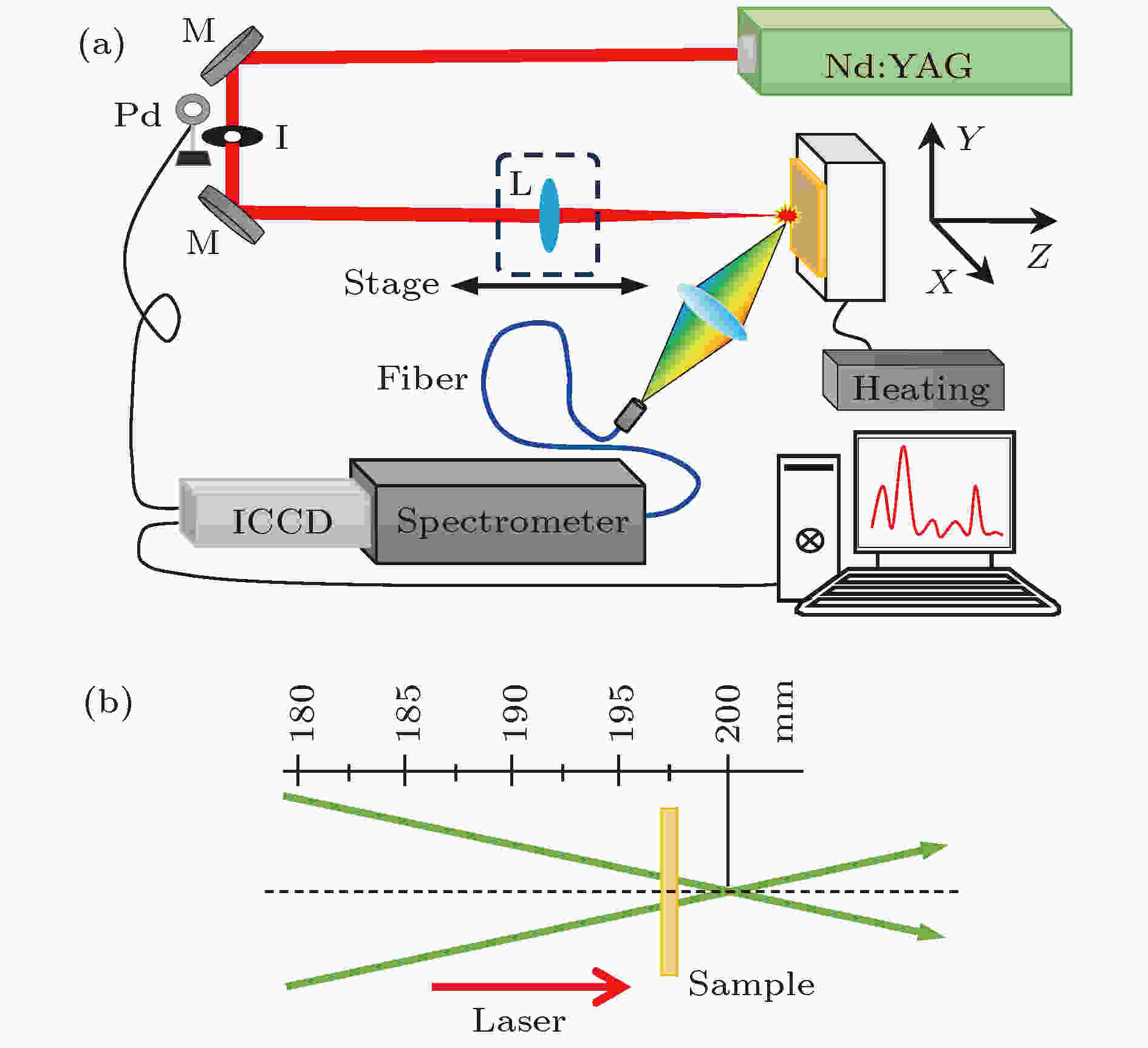
2019, 68 (6): 065201.
doi:10.7498/aps.68.20182198
Abstract +
From previously published results of laser-induced breakdown spectroscopy, one can know that the change in the distance from the sample surface to the focusing lens has an important influence on the interaction between the sample and the laser, and increasing the sample temperature can enhance the coupling between the laser and the sample. However, almost no work has devoted to directly studying the influence of the distance between focusing lens and sample surface on the spectral intensity of laser-induced breakdown spectroscopy under different sample temperatures. In this paper, we investigate experimentally this subject. An Nd:YAG laser is used to excite the sample to produce the plasma. The detected spectral lines are Cu (I) 510.55 nm, Cu (I) 515.32 nm, and Cu (I) 521.82 nm. The focal length of focusing lens is 200 mm. The distance between focusing lens and sample surface ranges from 170 mm to 200 mm. The sample is heated from 25 ℃ to 270 ℃, and the laser energy is 26 mJ. In general, the spectral intensity of laser-induced breakdown spectroscopy can be effectively enhanced by increasing the sample temperature. At the sample temperatures of 25 ℃ and 100 ℃, the spectral intensity increases monotonically with the increase of the distance between focusing lens and sample surface; at higher sample temperatures (150, 200, 250, and 270 ℃), the spectral intensity first increases and then decreases with the increase of the distance between focusing lens and sample surface. In addition, near the focal point, with the increase of sample temperature, the increase of the spectral intensity is not obvious, and the spectral intensity decreases with the increase of sample temperature, which is particularly noteworthy in improving the spectral intensity of laser-induced breakdown spectroscopy by increasing sample temperature. In order to further understand the influences of these two conditions on laser-induced breakdown spectroscopy, we also calculate the plasma temperature and electron density, and find that the variation of plasma temperature and electron density are almost the same as that of spectral intensity. The plasma temperature and electron density at higher sample temperature are higher.
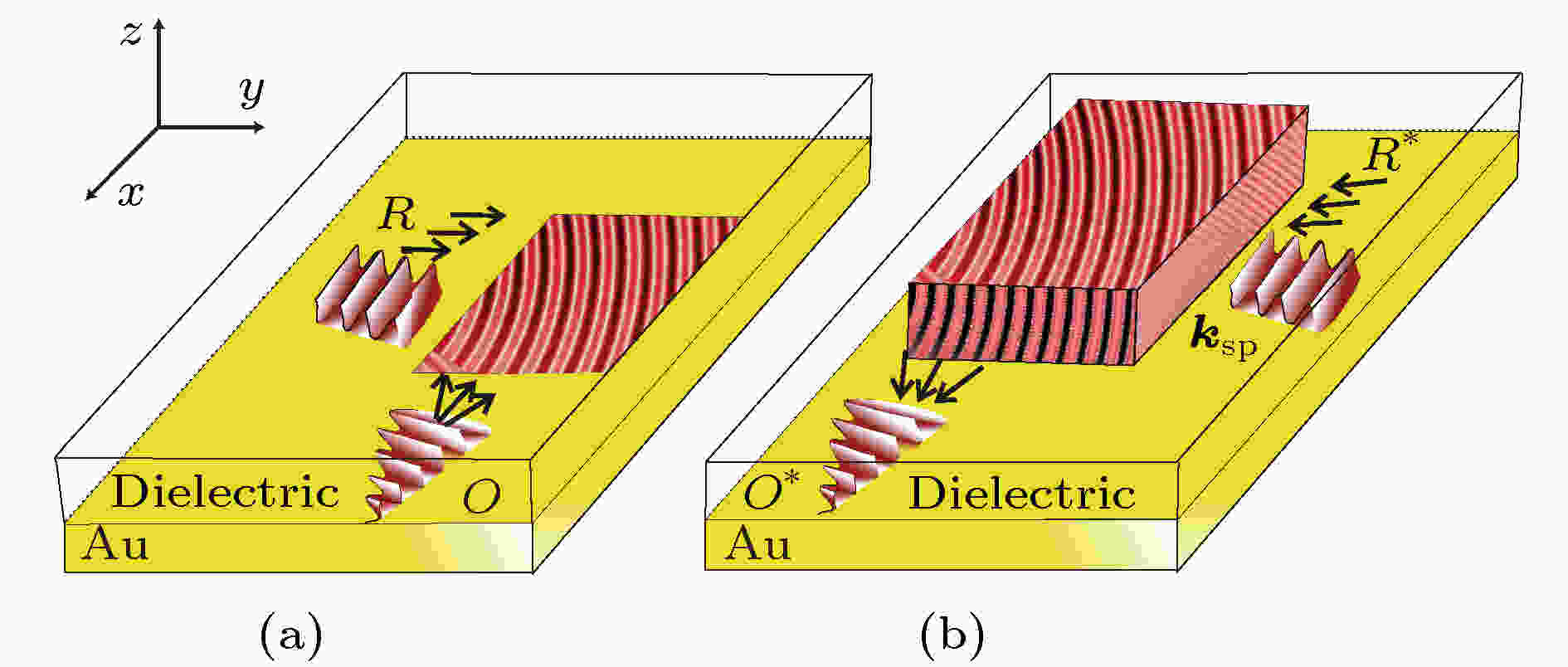
2019, 68 (6): 067101.
doi:10.7498/aps.68.20181664
Abstract +
Control of surface plasmon polaritons’ (SPPs’) propagation is of great importance. The groove structure in metal surface, designed by the surface electromagnetic wave holography (SWH) method, can control the SPPs’ propagation effectively. In the SWH method, all designed groove structures are etched in metal surface. The fabrication method is confined to the etching method, such as the focused ion beam lithography and electron beam lithography. And the designed structures cannot implement the real-time control of SPP propagation. We propose a new method to control SPPs’ propagation through metal-photorefractive material composite holographical (MPRCH) structures. A photorefractive material film is coated on the metal surface, and the reference SPP wave interferes with the object SPP wave in the photorefractive material film. The interference intensity is recorded by the photorefractive material film, forming the MPRCH structure. The MPRCH structure is used to control the propagation of relatively weak SPP waves. The finite difference time domain method is used to verify the method. We simulate that a reconstructed SPP wave is incident into the structure region and interacts with the structure. The incident wave is reflected and scattered by the designed MPRCH structure. These reflected and scattered wave are propagated and superposed, forming the desired SPP wave on the metal surface. Simulation results show that the MPRCH structure can control SPPs’ propagation effectively and realize the functions such as SPP wave aside single-point focusing, two-point focusing, generating zero-order and first-order Gaussian SPP beams. It is found that the optimal thickness of the MPRCH film is
$3.3\;{\text{μ}}{\rm{m}}$
and modulation amplitude of refractive index is 0.06. This method extends the SPP device fabrication methods, and gets rid of the etching method. Based on the investigation, the real-time controlling of SPP wave may be realized through the MPRCH structure. The study provides a new idea for realizing the all-optical control of SPP propagation, thus making it possible to implement the all-optical control of SPP and further switch.
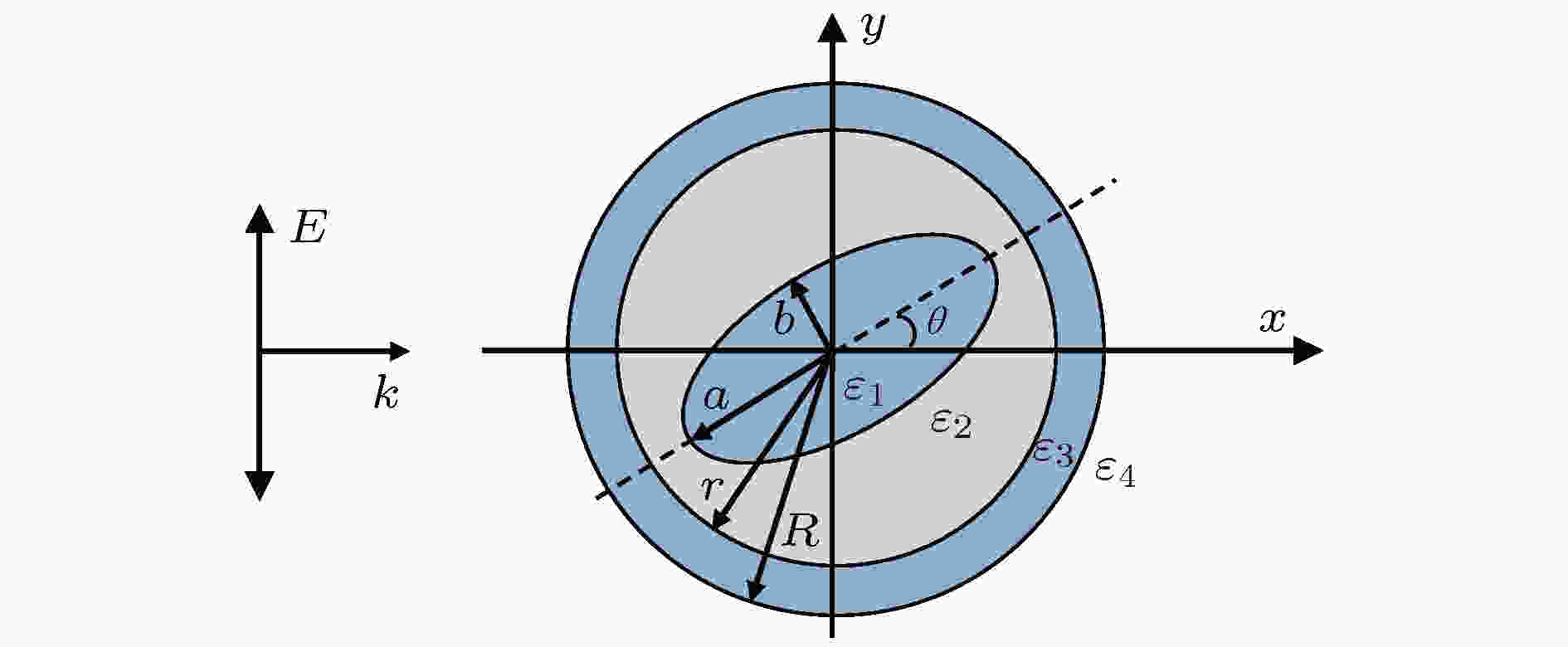
2019, 68 (6): 067301.
doi:10.7498/aps.68.20182249
Abstract +
Optical properties of the concentric composite nanostructure composed of gold nanotube around the center gold elliptical core are investigated based on the finite difference time domain method. According to the simulated absorption and scattering spectra, electric field distributions and charge distributions, we can generate double dipole-dipole Fano resonances by adjusting the angle between the elliptical cylinder core and the linearly polarized excitation light, which is due mainly to the interference between the subradiant dipole mode and the superradiant dipole mode. The narrow, low-energy subradiant mode originates from the symmetric hybrization between the longitudinal or transverse dipole mode of the elliptical cylinder core and the dipole bonding mode of the nanotube, and the broad, high-energy superradiant mode originates from the symmetric hybrization between the core’s dipole mode and the nanotube’s dipole antibonding mode. Moreover, the intensities and spectral positions of the two Fano resonances can be manipulated by modifying the geometric parameters of the composite structure. By increasing the semiminor axis of elliptical core, the high-energy Fano resonance red-shifts faster than the low-energy Fano resonance due to the increase of the interaction coupling between the transverse dipole mode of the core and the dipole mode of the nanotube, and becomes weaker in the scattering spectrum because of the reduced radiation intensity of the superradiant dipole mode. When the semimajor axis is changed, a similar phenomenon occurs in the low-energy Fano resonance. In addition, the two Fano resonances red-shift when outer radius of the nanotube increases, but the shift of low-frequency and high-frequency Fano resonance are inconsistent as the inner radius of the nanotube changes. The high-frequency Fano resonance red-shifts monotonically while the low-frequency Fano resonance first blue-shifts and then red-shifts with the increase of inner radius of nanotube because the red shift of the dipole bonding nanotube mode competes with the spectral shifts induced by the diminishing hybridization between elliptical core and nanotube mode. It can also be concluded that the dipole-dipole Fano resonances become apparent and higher order Fano resonance occurs when the composite nanostructure is scaled to a larger size due to the increased radiative damping. With the core and nanotube size fixed, Fano resonance is insensitive to the change of the external environment, but has a good response to the nuclear material of the nanotube.
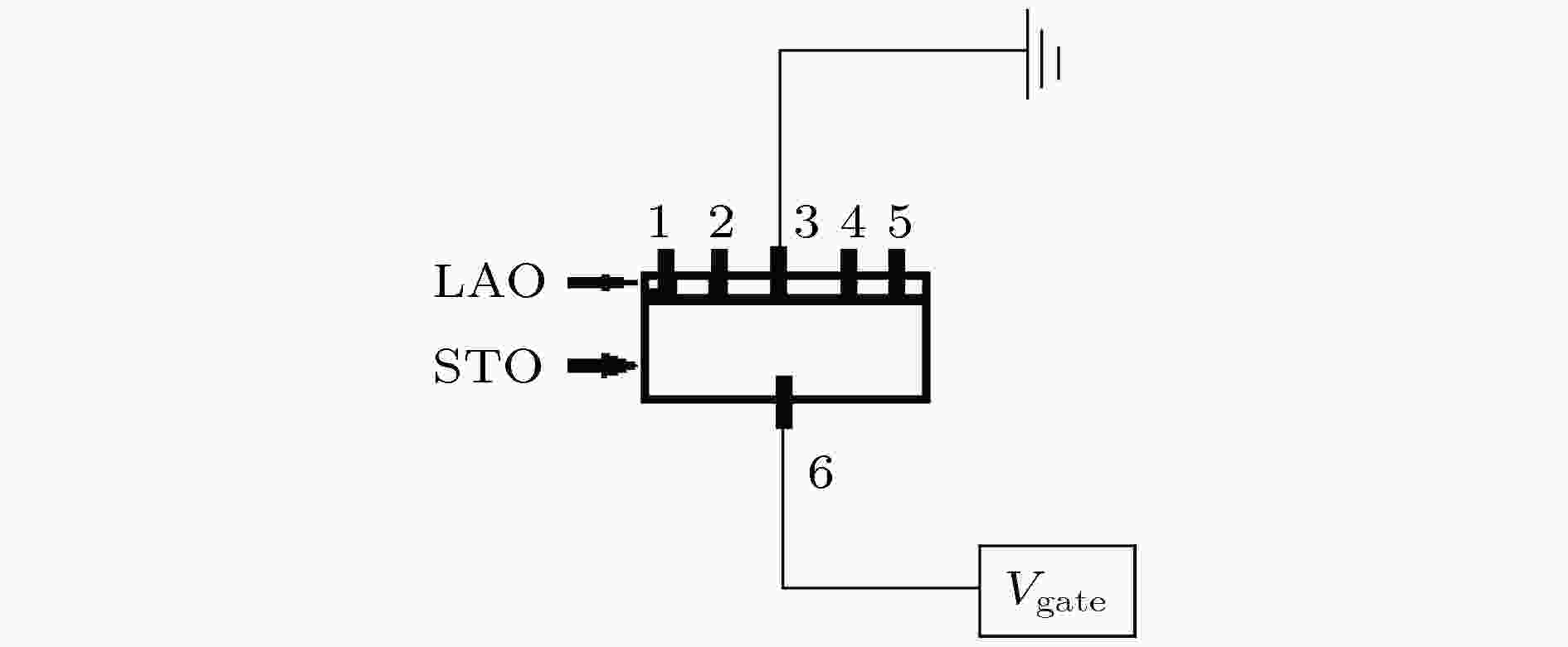
EDITOR'S SUGGESTION
2019, 68 (6): 067302.
doi:10.7498/aps.68.20182204
Abstract +
The LaAlO3/SrTiO3interface has been one of the topics studied most during the past few years due to its many intriguing properties such as the two-dimensional electron gas, transient photoconductivity (PC), persistent photoconductivity (PPC), and the coexistence of the PC and PPC. Of them, the PPC effect is the most interesting because of its potential application in exploring the photoelectric memory devices. Until now, tuning of the PPC of the LaAlO3/SrTiO3interface under the external stimuli, such as electric or magnetic field is less addressed, while the relevant knowledge is of great value for exploring the memory devices with multifunctionality. In this paper, we report on an electric field control of the persistent PPC at the LaAlO3/SrTiO3interface. Our LaAlO3/SrTiO3heterojunction is fabricated by growing the LaAlO3film on the SrTiO3substrates through using pulsed laser deposition. The substrate temperature is kept at 750 ℃ and the partial pressure of oxygen is maintained at 3.3 × 10–5Torr (1 Torr = 1.33322 × 102Pa) during the deposition. The thickness of LaAlO3film is controlled to be about 2 nm by setting an appropriate deposition time. The X-ray diffraction experiment confirms that the LAO film is well epitaxial and of single phase. To guarantee the good electric contacts, Al electrodes are soldered at the LaAlO3/SrTiO3interface and the back side of the SrTiO3respectively by ultrasonic welding. We find that the PPC at the LaAlO3/SrTiO3interface can be significantly reinforced and modulated by the light-enhanced gating effects: that is, after a negative back gate voltage processing combined with a simultaneous light illumination, the LaAlO3/SrTiO3interface can exhibit a notable PPC effect. And the PPC effect increases as the negative gate voltage increases, and then attains a maximum at a back gate voltage of about –70 V. Further increase of the negative gate voltage can cause the PPC to decrease. Additionally, the PPC is also found to increase monotonically with increasing the gating time. The present result can be understood in terms of the migration of the oxygen vacancies under the influence of photoelectric synergetic effect. This field enhanced PPC effects at the LaAlO3/SrTiO3interface may find their applications in designing the photoelectric memory devices with electric tunability.

2019, 68 (6): 067501.
doi:10.7498/aps.68.20181806
Abstract +
Amorphous FeSiB ribbons with nominal composition of Fe78Si9B13are prepared by single roll rapid quenching technique. In order to enhance the giant magneto-impedance (GMI) effect of FeSiB ribbons, interlaminar gluing method is used to produce FeSiB/Cu/FeSiB sandwiched structure in which the FeSiB ribbons act as external soft magnetic layers and the Cu foil acts as internal conductive layer. The variation characteristics of GMI with angle
$\beta$
between the external magnetic field and the ribbon axis for the single layer FeSiB ribbon and the sandwiched ribbon are studied by a rotating device placed in magnetic field which can drive the sample to rotate, to obtain a variable angle
$\beta$
from 0° to 90° with 15° degree angle interval. Magnetic domain structure detection shows that the amorphous FeSiB ribbons have near-axial magnetic anisotropy, and the angle between easy axis and ribbon axis is about 15°. In this work, in the case without considering the effects of shape anisotropy, the functional relationship among magnetic field at anisotropic peak of permeability, transverse permeability ratio and angle
$\beta$
is obtained according to the expression of the transverse permeability of ribbon derived from a domain rotation model. The results display that anisotropic peak appears in the transverse permeability for each of all testing values of angle
$\beta$
. Moreover, the transverse permeability ratio increases with
$\beta$
increasing. The magneto-impedance testing results indicate that the maximum GMI ratio of single layer ribbon is only about 30% at an optimum response frequency of 7.0 MHz, and angle
$\beta$
has almost no influence on the GMI. In contrast, the GMI of sandwiched ribbon presents a significant enhancement, the maximum value of the longitudinal GMI ratio and that of transverse GMI ratio reach 272% and 464%, respectively at an optimum response frequency of 0.6 MHz, the GMI of sandwiched ribbon is sensitive to the variation of angle
$\beta$
, and with increase of
$\beta$
the GMI increases accordingly. In addition, for all testing values of angle
$\beta$
, the GMI profiles of sandwiched ribbon show anisotropic peaks, due to the influence of transverse demagnetization field, and the anisotropic peak broadens with the increase of angle
$\beta$
. By comparing the theoretical and experimental results, it can be concluded that for the sandwiched ribbon, the characteristics of GMI changing with angle
$\beta$
agree better with the theoretical transverse permeability, which but is not for single layer ribbon. Besides, whether the anisotropic peak of GMI appears is independent of the orientation of the external magnetic field. As the transverse permeability ratio increases with the increase of angle
$\beta$
, the GMI effect of sandwiched ribbon is enhanced accordingly. The study results also demonstrate that the domain rotation model can be used to explicate the variation of GMI properties of sandwiched ribbon with the angle between magnetic field and ribbon axis qualitatively when the domain rotation magnetization is dominant.

An effective reduction on secondary electron emission yield of gold coated surfaces by laser etching
2019, 68 (6): 067901.
doi:10.7498/aps.68.20181547
Abstract +
Multipactor is a frequent discharging phenomenon for space high-power microwave components, and this detrimental effect is mainly induced by secondary electron emission (SEE) and electron resonance in vacuum. Plenty of researches have verified that suppressing SEE is an efficient approach to mitigate the multipactor. Therefore, low SEE yield surfaces are urgently needed for mitigating the multipactor in the field of space science. In the past few decades, a number of technics have been developed to acquire low SEE yield surfaces, including surface coating, surfaces roughening, depositing coessential nanostructure, etc. Laser etching has been partly reported to be an advisable way to construct micro- or nano-structure on some materials’ surfaces, and able to further suppress the SEE yield. Whereas, employing laser etching to obtain the SEE yield reduction on gold coated surfaces is rarely investigated. In this work, by using the laser etching technic, we fabricate four micro hole arrays and three orthogonal groove arrays with various porosities and aspect ratios, and we also characterize their three-dimensional and accurate two-dimensional morphologies. In addition, we investigate the dependence of SEE yield on surface morphology. Experimental results indicate that the laser etched microstructures can effectively suppress the SEE yield from gold coated surfaces, and the suppression levels on SEE yield of these samples are superior to those of many other low SEE yield technics. Furthermore, experiments reveal that the ability to suppress the SEE yield is positively related to the porosity and aspect ratio, as well as that the porosity influences SEE yield more strongly than the aspect ratio does. To theoretically verify the experimental phenomena, we utilize the Monte Carlo method combining with the SEE phenomenological model and the electron trajectory tracking algorithm, to simulate the SEE characteristics of the fabricated microstructures. And the simulation results can qualitatively explain the experimental phenomena. This work digs out an advisable method to sharply reduce the SEE yield from gold coated surfaces by laser etching, which is of considerable importance for exploiting the low SEE yield surface engineering in space microwave systems, and for improving the performance of the space microwave components with gold coated surface.
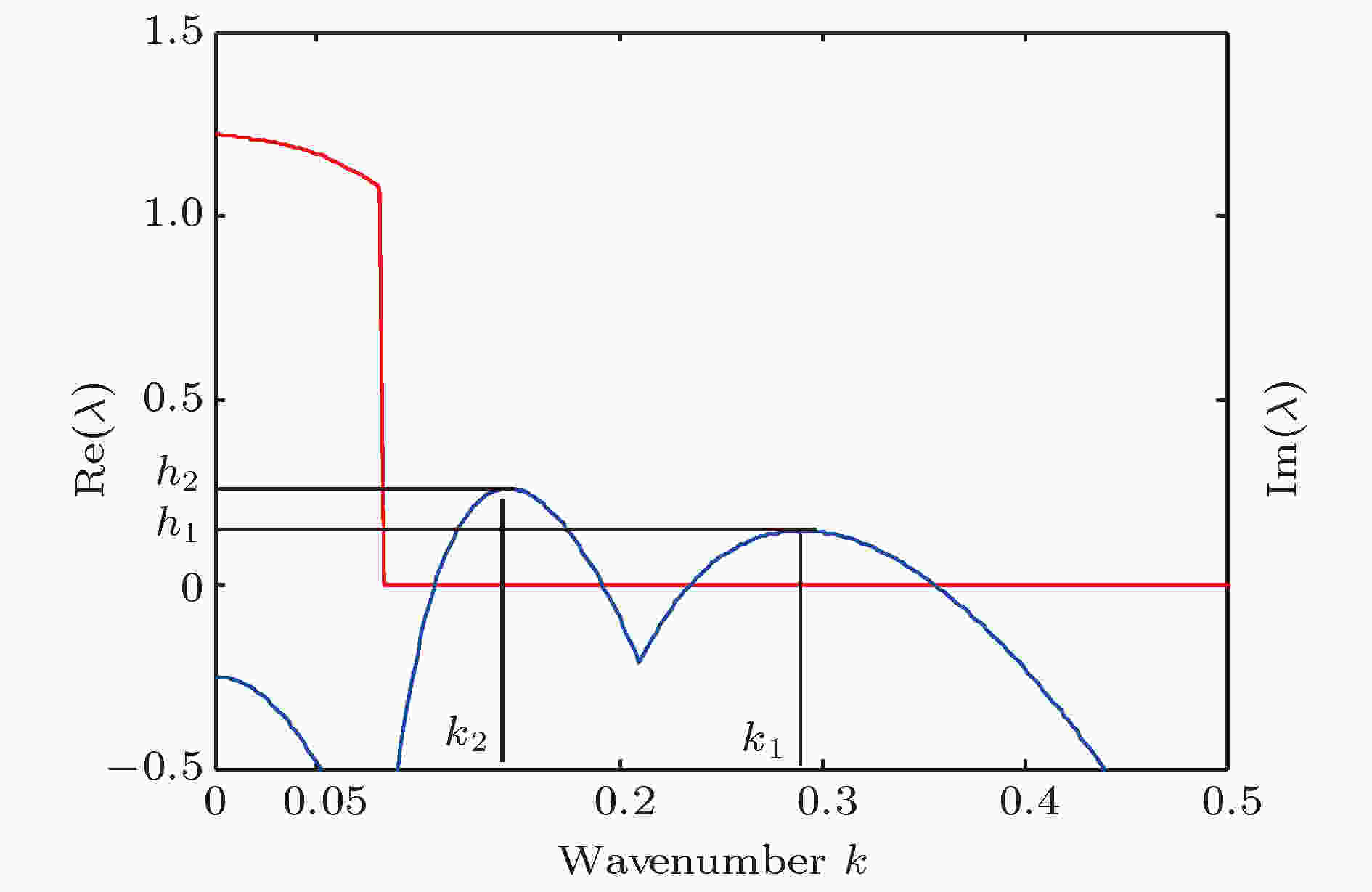
2019, 68 (6): 068201.
doi:10.7498/aps.68.20182167
Abstract +
In this paper, the simple and superlattice square patterns in two-dimensional space are investigated numerically by the two-layer coupled Lengyel-Epstein model. When the wave number ratio of Turing modes is greater than one, our results show that the spatial resonance form of the fundamental mode is changed with the increase of coupling strength, and simple hexagon pattern evolves spontaneously into a new pattern with a complicated structure. In addition to the reported superlattice hexagonal pattern, simple square pattern and superlattice square pattern are obtained, such as the complicated big-small spot, spot-line, ring and white-eye square pattern. The characteristics of simple and complicated superlattice square pattern are investigated by the intermediate process of evolution. When the coupling parameters
$\alpha $
and
$\beta $
increase synchronously within a certain range, the type I square patterns of the same wavelength are obtained in the two subsystems. When the coupling parameters
$\alpha $
and
$\beta $
increase asynchronously, the type I square pattern can evolve into the type II square pattern on the same spatial scale through phase transition. Then, the new subharmonic modes are generated, and the complicated superlattice square patterns are obtained due to the resonance between the two Turing modes in a short wavelength mode subsystem. The influence of coupling between two subsystems on the square pattern is investigated. When the type I square pattern of wavelength
$\lambda $
emerges, the square pattern will quickly lose its stability in the short wavelength mode subsystem, since the coupling coefficient is equal to zero. Finally a new square pattern of wavelength
$\lambda $
/Nis formed. The type I square patterns of two subsystems successively evolve into the type II square patterns through the phase transition. The spots move relatively with the extension of simulation time, and a new mode is generated and forms three-wave resonance in two subsystems, and then the hexagonal pattern dominates the system. Our results also show that the type II square pattern spontaneously transforms into a hexagonal pattern.
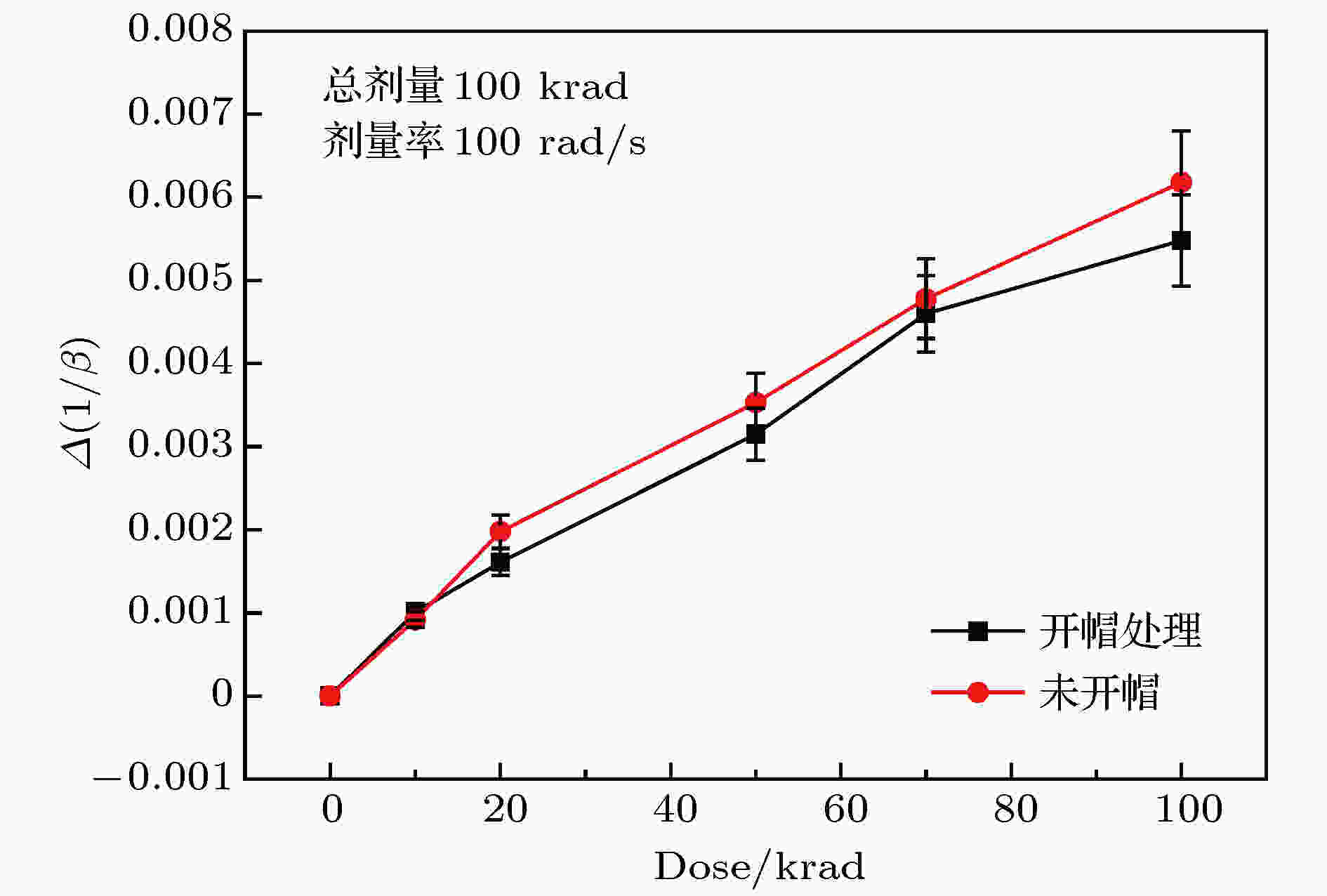
2019, 68 (6): 068501.
doi:10.7498/aps.68.20181992
Abstract +
Bipolar devices are extremely sensitive to ionization effects, and their low dose rate radiation damage is more serious than their high dose rate radiation damage, which phenomenon is especially named enhanced low dose rate sensitivity. In the actual space radiation environment, the radiation dose rate of the device is extremely low. Currently, the enhanced low dose rate sensitivity effect has become a key factor of evaluating the reliability of spacecraft and its electronic systems, due to the fact that the low dose rate irradiation test needs longer time. The method to speed up the test on the ground is one of the hottest topics in this research area. In recent years, some researches have suggested that the use of hydrogen immersion irradiation for accelerating the test can simulate low dose rate radiation damage to some extent, but the damage mechanism has not been analyzed in detail. In this paper, the mechanisms of electrical properties and deep level defects for the 3DG111 transistor by60Co gamma ray under high and low dose rates in the cases with and without hydrogen are investigated. In order to analyze the damage mechanism of bipolar junction transistor, the excess base current and deep level transient spectrum are measured by using semiconductor parameter analyzer and deep level transient spectroscopy. The experimental results show that the current gain degradation of 3DG111 transistor is more serious under low dose rate radiation than under high dose rate radiation, at the same time, the excess base current of transistor increases significantly. This shows that in the device there appears the enhanced low dose rate sensitivity. Under both high dose rate radiation and low dose rate irradiation, the radiation damage defects are the traps for both oxide positive charge and interface state. Under the low dose rate irradiation, there are two main reasons for the increase in transistor damage. First, the oxide charge concentration increases under low dose rate irradiation, and the oxide charge and interface state energy levels move toward the middle band. Eventually, the space charge region recombination of the transistor is intensified, and thus causing the excessive base current of the transistor to increase and transistor performance to degrade. The comparison shows that the number and type of defects under the high dose rate irradiation are the same as those under the low dose rate irradiation. Based on the analysis, the hydrogen treatment can be used as an effective method of accelerating the assessment of radiation damage enhancement effect at low dose rates.
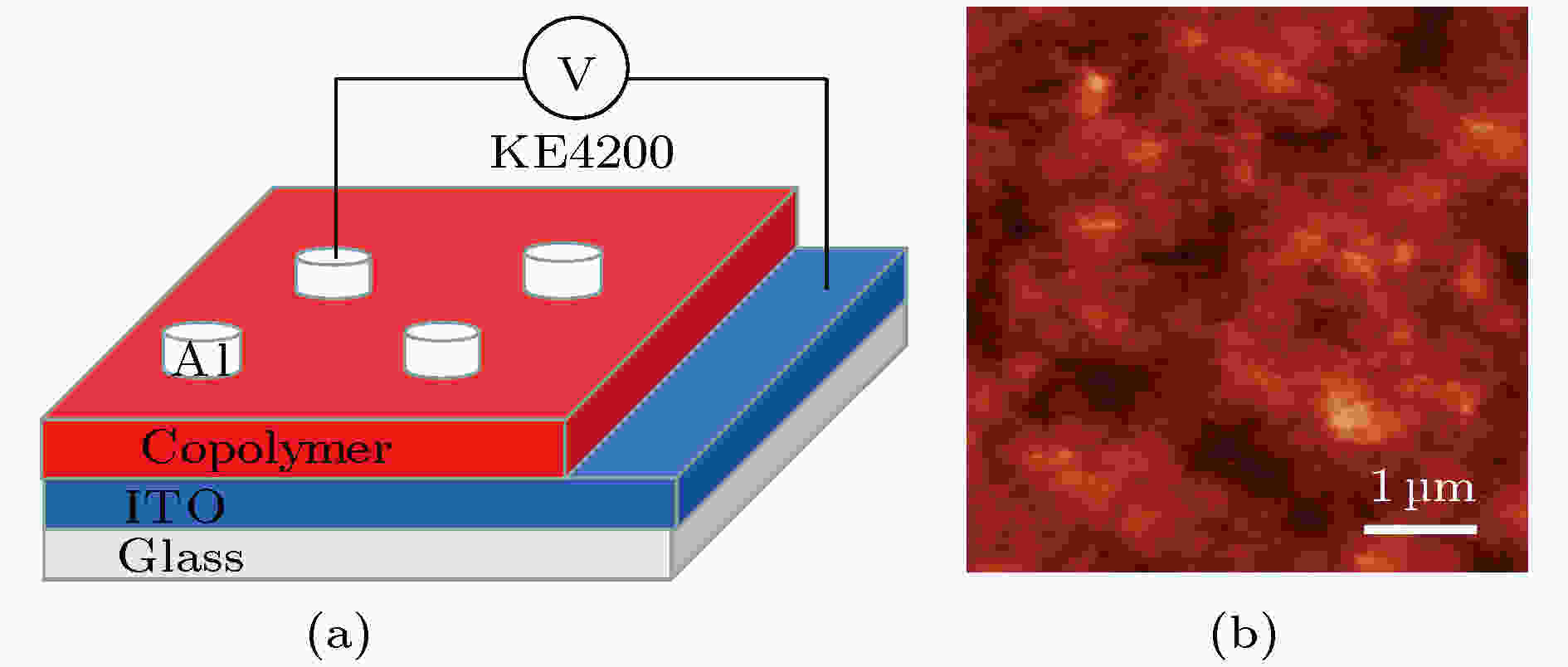
2019, 68 (6): 068502.
doi:10.7498/aps.68.20181836
Abstract +
With the advent of the information age, big data put forward higher requirements for capacity of storage devices. Compared with the method of reducing the size of the device to enhance the integration level, the high density storage of increasing the memory state of the single device will be very beneficial to solving the problem. In this work, we propose an idea of two-parameter and multi-state memory device involved in both resistance and capacitance operation levels. At first, a new donor-acceptor (D-A)-type copolymer is designed and synthesized. Then, the memory device of Al/copolymer/ITO structure is fabricated, and the current-voltage (I-V) and capacitance-voltage (C-V) curves are measured by a KEITHLEY 4200 semiconductor characterization system. The device not only displays the obvious memory resistance characteristics, but also has the memory capacitance behavior in single resistance state, which results in two resistance states and four capacitance states, so that the device has the capability of two-parameter and multi-state memory. In addition, the device shows more capacitance states after the switching behavior has been modulated by the voltage amplitude, which provides an effective method to control the memory states. In order to study the conductive mechanism of the device, we test the relationship between resistance and temperature. It is found that the resistance decreases with the increase of temperature, indicating that the device has the obvious semiconductor properties. Furthermore, the fitting results ofI-Vdata show that the mechanism of resistance switching is in good consistence with the classical trap-controlled space charge limited current theory. The capacitance switching in single resistance state is closely related to the polarization characteristic of D-A structure in the copolymer film. The polarization force microscopy phase image shows that the copolymer film has obvious polarization and depolarization characteristics under the external electric field. Based on the polarization characteristics of copolymer, the correlation between memory resistance and memory capacitance is established by introducing a polarization operator of molecules, and the matrix model describing the two-parameter and multi-state memory characteristics is given. The above results show that the multi-state memory characteristics will store more information than 2-bits mode in a single cell, which will provide a reference for improving the storage density of information.
INVITED REVIEW
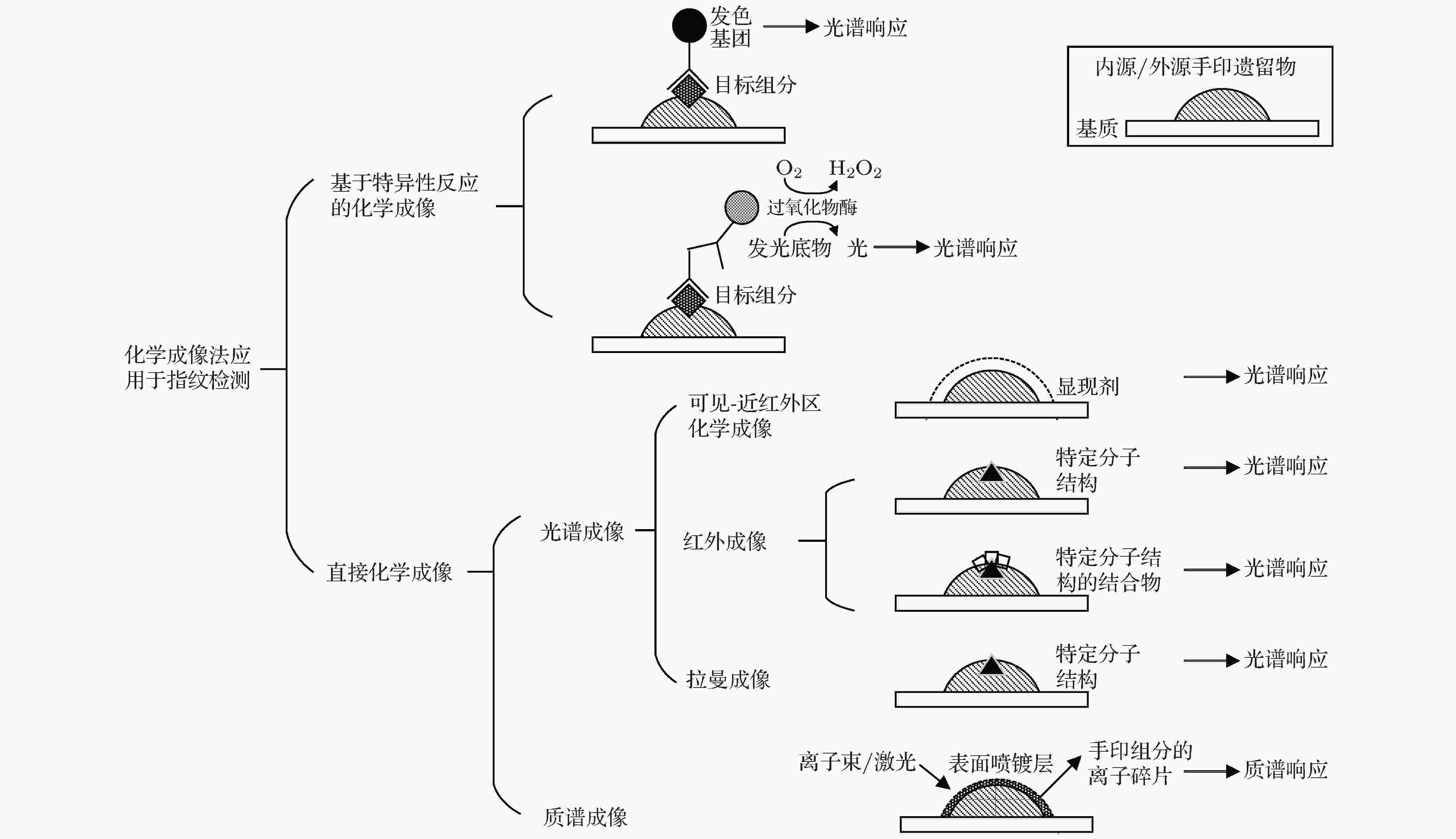
2019, 68 (6): 068701.
doi:10.7498/aps.68.20190174
Abstract +
Developing on advanced light sources, especially those applied in the areas of spectral imaging and mass spectrometry imaging, has made the trace analysis feasible and more reliable. These techniques show great potentials in various fields including forensic science, environment, food, pharmaceuticals, archaeology, etc. In many cases of trace analysis, it is expected to obtain both the spatial distributions and chemical compositions of the target objects. Through the combination of imaging technology with optical spectroscopy and mass spectrometry, it is possible to detect the trace chemicals on the surface of various materials as well as their spatial distributions, thus improving the accuracy of detection and the range of application. Moreover, trace analysis based on such methods can reduce or even avoid the use of special chemical reagents, and is compatible with the traditional chemical detection methods. In the paper, we focus on fingerprint visualization and analysis, as a typical trace analysis issue, to discuss the recent progress of the applicable chemical imaging technologies based on the advanced light sources. The effect of latent fingerprint development depends on not only features of fingerprint carrying object, but also the characteristics of fingerprint residues. In this paper, we provide an overview of two technical approaches: specific component targeted chemical imaging and nondirective chemical imaging. We describe the major technologies involved in this field, including visible-near infrared chemical imaging, mid-infrared chemical imaging, Raman imaging, and mass spectrometry imaging.


























































































